lordroel
Administrator
Posts: 68,086 
Likes: 49,471
|
Post by lordroel on Jun 9, 2024 5:37:24 GMT
Day 2099 of World War II, June 9th 1945Allied occupied GermanyField Marshal Montgomery takes the salute at the last parade of the British Guards Armored Division. YugoslaviaAn agreement was signed in Belgrade in which Yugoslavia agreed to evacuate Trieste and allow it to be occupied by an allied military government until the competing claims to the region were resolved. United KingdomThe RAF reveals the Vampire, a new jet fighter capable of flying at speeds over 500 miles per hour. United States1.5 million people watched a victory parade for George S. Patton and James Doolittle in Los Angeles, California. The parade was followed by a show in their honor at the Memorial Coliseum emceed by Jack Benny. Photo: Patton during a welcome home parade in Los Angeles, June 9, 1945 Pacific War YouTube (Japan News No. 252 - 9 June 1945 - English translation available) Pacific War YouTube (Japan News No. 252 - 9 June 1945 - English translation available)CHINA (Fourteenth Air Force): 3 B-25s and 60+ P-47s, P-51s, and P-40s damage 4 bridges, hit river shipping, pound town areas and villages, and attack various targets of opportunity around Nanyang, Burma and Hwayuan, Changte, Suchow, Sinyang, Hankow, Laohokow, Tatung, Tashihkiao, Pinyang, Luchai, Kiehsiu, Linfen, Tsinan, and Shihkiachwang, China. INDIA-BURMA (Tenth Air Force): The 83d Bombardment Squadron (Medium), 12th BG (Medium), moves from Fenny to Pandaveswar, India with B-25s. TINIAN (Twentieth Air Force): Five missions are flown. Mission 191: 44 B-29s attack the Kawanishi Aircraft Company's plant at Narao; 1 other hits a target of opportunity. Mission 192: 24 B-29s hit the Kawasaki plant at Akashi; there is 9/10 cloud cover and bombing is by radar; the village of Akashi rather than the factory is hit; 2 others bomb targets of opportunity. Mission 193: 42 B-29s hit Aichi's Atsuta factory; only 4 bombs hit the target area but 1 causes a devastating fire; 1 other hits a target of opportunity. Mission 194: During the night of 8/9 Jun, 26 B-29s mine Shimonoseki Strait; 1 other mines an alternate target. 20 P-47s from Ie Shirna strafe various targets of opportunity on Kyushu. 57 P-51s from Iwo Jima pound Kagamigahara Airfield and the surrounding area in the Nagoya area; 20+ parked airplanes are claimed destroyed or damaged; 3 P-51s are lost. SOUTHWEST PACIFIC AREA [Far East Air Force]: The 550th Night Fighter Squadron, XIII Fighter Command, based at Tacloban with P-38s, P-61s and P-70s, sends a detachment to operate from Puerto Princesa (other detachments are at Zamboanga and Sanga Sanga). JAPAN Japanese Prime Minister Kantarō Suzuki told the Diet that Japan would "fight to the last." Japanese Privy Seal Kido today gains the approval of the Emperor on a scheme to mediate peace through the USSR. This plan features: (1) Honourable terms for Japan. (2) Withdrawal from occupied areas at Japan's initiative. (3) Acceptable arms reductions. JAPANESE OCCUPIED BRITISH BORNEO Photo: USS Killen (DD-593) refueling from an oiler, while en route to the Brunei Bay landings on 9 June 1945. Photographed from USS Aulick (DD-569) BORNEO CAMPAIGN (1945) In Borneo, Labuan Island is bombed by B-24s and other B-24s drop napalm on Brooketon. PHILIPPINE CAMPAIGN (1945) On Luzon, the US 37th Division captures Bagabag. The American forces attempt to block the routes into the Cagayan valley in order to isolate the Japanese forces concentrated in the Sierra Madre, in the northeast. On Mindanao, elements of the US 24th Division take Mandog, the last major strong point in the Japanese defenses. On Luzon Island, fighter-bombers hit Cagayan Valley targets and support ground forces in the Cervantes areas. Ground forces penetrate the last defensive position on Mindanao Island. Bad weather cancels operations N of the Philippine Islands. VOLCANO AND RYUKYU ISLANDS CAMPAIGN On Okinawa, the Japanese forces defending the Oroku peninsula are cut off and surrounded by forces of the US 6th Marine Division. The US 1st Marine Division advance southward to Kunishi Ridge, one of the last Japanese strong points. Photo: Second Division Marines stormed ashore at Aguni Jima, 30 miles west of Okinawa, 9 June 1945. Shown: Amphibious tanks approach in formation at Aguni Jima. The is wreathed n smoke from the pre-invasion bombardment by U.S. Pacific Fleet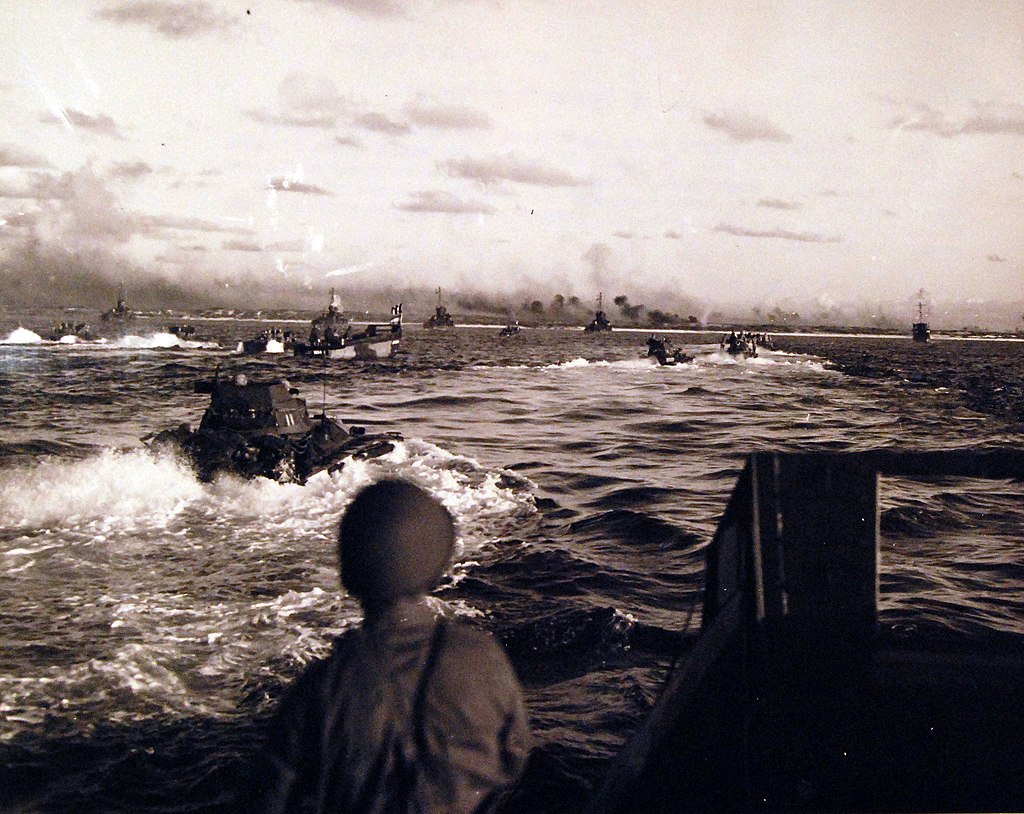 Photo: Marine Artillerymen of 15th Marines Move their 105mm Howitzer, 9 June 1945 Photo: Marine Artillerymen of 15th Marines Move their 105mm Howitzer, 9 June 1945 Photo: One rifleman reloads, and another fires in the 96th Infantry Division's advance to capture Big Apple Hill, scene of intense fighting on Okinawa, 9 June 1945 Photo: One rifleman reloads, and another fires in the 96th Infantry Division's advance to capture Big Apple Hill, scene of intense fighting on Okinawa, 9 June 1945 Naval task group (Rear Admiral Lawrence F. Reifsnider) lands Marines on Aguni Jima, Ryukyus. Naval task group (Rear Admiral Arthur W. Radford) bombs and bombards Okino Daito Jima, Ryukyus. ALASKA (Eleventh Air Force): In coordination with US Navy surface and air forces attacking in the Kurile Islands, 6 B-24s and 8 B-25s fly extensive armed weather reconnaissance and anti-shipping sweeps over Kurabu and Otomari Capes, Ichinowatashi, and Asahigawa on Paramushiru Island; the B-24s score no results, half of them jettisoning their bombs; the B-25s then fly a diversionary bombing mission over Araido Island where they are attacked by 8 Japanese fighters; to evade them, the B-25s fly over Kamchatka where Soviet AA fire shoots down one, killing its crew; another damaged B-25 crash-lands in Petropavlovsk. This is the first time Soviet AA hits a US aircraft. Photo: The Soviet naval ensign is raised aboard large infantry landing craft (LCI(L)s) at Cold Bay, Territory of Alaska, as they are commissioned into the Soviet Navy immediately after their decommissioning by the United States Navy and transfer to the Soviet Union as a part of Project Hula. Redesignated desantiye suda (DS) ("landing ship") in the Soviet Navy, 9 June 1945 PACIFIC Twenty-seven USAAF B-29s mine Shimonoseki Straits. Submarine Sea Owl (SS-405) sinks Japanese Coast Defense Vessel No.41 in Tsushima Strait, southeast of Mokpo, Korea, 34°22'N, 128°11'E. Submarine Crevalle (SS-291) sinks Japanese merchant cargo ship Hokuto Maru west of Aomori Prefecture, in western approaches to Tsugaru Strait, 40°54'N, 139°48'E. Submarine Sea Dog (SS-401) attacks Japanese shipping off northwest coast of Honshu, sinking merchant cargo ships Sagawa Maru and Shoyo Maru, 38°10'N, 138°20'E. Submarine Tench (SS-417) sinks Japanese transport Kamishika Maru off southern Hokkaido, 41°49'N, 141°11'E. Submarine Tinosa (SS-283) sinks Japanese merchant cargo ship Wakatama Maru off east coast of Korea, 37°32'N, 129°10'E. Mines laid by USAAF B-29s (20th Air Force) sink Japanese merchant cargo ships No.35 Banshu Maru, 36°19'N, 136°12'E, and Inaura Maru, .7 kilometers off Takase light, 34°00'N, 131°00'E. PB4Ys or PBMs sink Japanese merchant cargo ship No.5 Kaishin Maru at 37°05'N, 129°08'E. USAAF B-24s bomb Japanese shipping off Bandjermasin, sinking cargo vessel Koryu Maru and 423 Shuttle Boat and No.444 Shuttle Boat, and damaging cargo vessel No.8 Nippo Maru.
|
|
lordroel
Administrator
Posts: 68,086 
Likes: 49,471
|
Post by lordroel on Jun 10, 2024 2:48:04 GMT
Day 2100 of World War II, June 10th 1945Allied occupied GermanyIn Frankfurt, Marshal Zhukov confers the Soviet Order of Victory on Field Marshal Montgomery and General Eisenhower. During the evening, in a message broadcast by Hamburg radio, Field Marshal Montgomery says that the German people must be taught that not only have they been defeated, but that they are guilty of beginning the war as they were guilty in 1914. He suggests parents read the message to their children and ensure that they understand it. Photo: Marshal Zhukov decorates Field Marshal Montgomery with the Russian Order of Victory. Allied chiefs who attended the ceremony at Gen. Eisenhower's Headquarters at Frankfurt are about to drink a toast, 10 June 1945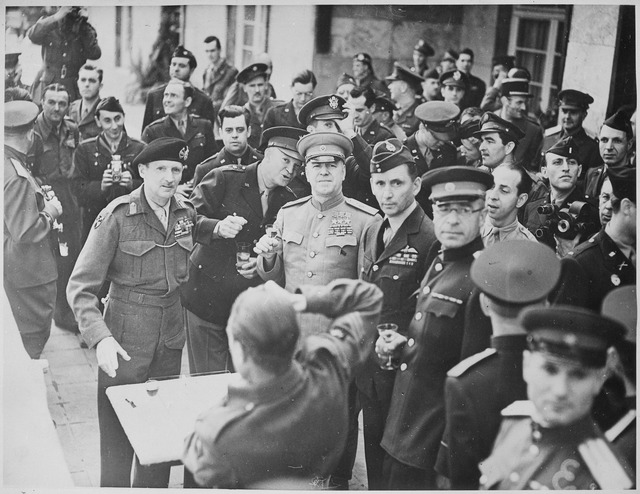 NorwayPhoto: Panzer-Brigade 'Norwegen' handing over their tanks and assault guns to British army and Norwegian MILORG personnel in the Akershus district outside Oslo,10 June 1945 NorwayPhoto: Panzer-Brigade 'Norwegen' handing over their tanks and assault guns to British army and Norwegian MILORG personnel in the Akershus district outside Oslo,10 June 1945 Photo: Panzer-Brigade 'Norwegen' handing over their tanks and assault guns to British army and Norwegian MILORG personnel in the Akershus district outside Oslo, 10 June 1945 Photo: Panzer-Brigade 'Norwegen' handing over their tanks and assault guns to British army and Norwegian MILORG personnel in the Akershus district outside Oslo, 10 June 1945 YouTube (The surrender of German panzers to British and Norwegian troops in Norway) YouTube (The surrender of German panzers to British and Norwegian troops in Norway)Mute edited footage originally shot by US Signal Corps cameramen showing men serving with Panzer-Brigade-Norwegen handing over their tanks and assault guns to British army and Norwegian MILORG personnel in the Akershus district outside Oslo circa 10 June 1945 following the unconditional surrender of all German forces. The location is Trandum, the site of a former Norwegian Army training camp. The British officer seen taking the surrender of the commanding officer of Panzer-Brigade-Norwegen (and his adjutant) has been identified as Lt-Colonel O J O'Connor. The tanks seen in this film are late-mark Panzer III medium tanks armed with either short-barrelled 7.5cm L/24 cannon or the long-barrelled 5cm L/60 cannon and have been fitted with "Schuezen" 8mm armour plates as protection for their turrets and also in several instances seen here to their hull sides against anti-tank rifle rounds. By 1945, the Panzer III was regarded as obsolete by German panzer commanders but no doubt the German garrison in Norway, denied access to more powerful tanks by the Nazi high command on the grounds they were needed on war fronts where fierce combat was taking place, found their presence in its order of battle reassuring. Pacific WarCHINA (Fourteenth Air Force): In China, 14 P-51s damage a bridge near Singtai and attack barracks, river-craft, fuel dumps, trucks and other targets of opportunity around Taohsien, Lingling, Liuchow, and Kaifeng. Chinese forces capture the port of Wenchow (I-shan) and pursue the Japanese forces toward Liuchow. INDIA-BURMA (Tenth Air Force): HQ 4th Combat Cargo Group and the 13th, 14th and 15th Combat Cargo Squadrons move from Chittagong to Namponmao, Burma with C-46s. BURMA Burmese guerrillas led by British officers retake Loilem, in the Shan Mountains area. JAPAN Prime Minister Suzuki is granted dictatorial powers by the Imperial Diet. TINIAN (Twentieth Air Force): 6 missions are flown. Mission 195: 23 B-29s attack the seaplane base at Kasumigaura; 2 others hit alternate targets. Mission 196: 32 B-29s bomb and the Japan Aircraft Company plant at Tomioka; 1 other hits an alternate target. Mission 197: 118 B-29s are dispatched to hit the Nakajima Aircraft plant at Musashi; clouds cover the target and they hit the Hitachi engineering works at Kaigan; 2 others hit alternate targets. Mission 198: 26 B-29s attack the Hitachi plant at Chiba. Mission 199: 52 B-29s hit the Nakajima plants at Ogikubu and Omiya; 4 others hit alternate targets; 1 B-29 is lost. Mission 200: 29 B-29s attack the Tachikawa Army Air Arsenal and 3 others hit alternate targets. The VII Fighter Commands sends 107 P-51s to escort the B-29s; 27-7-10 Japanese aircraft are claimed without loss. 39 Ie Shima based P-47s sweeping Kyushu strafe numerous ground targets of opportunity, and claim 17 aircraft shot down. BORNEO CAMPAIGN (1945) On Borneo, almost 30,000 men of the Australian 9th Division make an unopposed landing in Brunei Bay (Operation Oboe VI). Small contingents also make assault landings on the islands of Labuan and Muara nearby. Naval support forces are under the command of Admiral Royal. A naval bombardment in support of the landings was conducted by a force of cruisers and destroyers under the command of Admiral Berkey. Photo: The U.S. Navy landing craft repair ship USS Proserpine (ARL-21) underway on 10 June 1945, wearing this as yet unidentified camouflage pattern, probably in greens Photo: USS LCI(R)-74 firing rockets at the landing beaches prior to waves coming in, at Brunei Bay, Borneo, on 10 June 1945. Other LCI(R ) and LCS are in the background Photo: USS LCI(R)-74 firing rockets at the landing beaches prior to waves coming in, at Brunei Bay, Borneo, on 10 June 1945. Other LCI(R ) and LCS are in the background Photo: Crowded US Navy LCIs approaching Labuan on 10 June 1945 Photo: Crowded US Navy LCIs approaching Labuan on 10 June 1945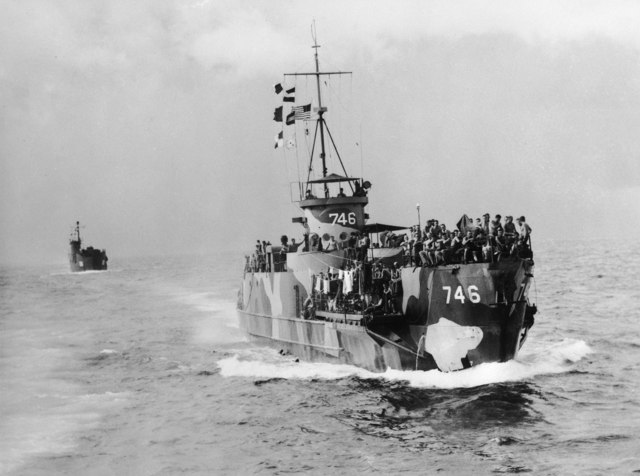 Photo: Troops of 2/17 Infantry Battalion approaching Green Beach in Landing Craft Vehicle Personnel (LCVP). They are part of the second wave landing during the Oboe 6 Operation, 10 June 1945 Photo: Troops of 2/17 Infantry Battalion approaching Green Beach in Landing Craft Vehicle Personnel (LCVP). They are part of the second wave landing during the Oboe 6 Operation, 10 June 1945 Photo: Australian troops land from USS LST-560, at Labuan Island in Brunei Bay, 10 June 1945 Photo: Australian troops land from USS LST-560, at Labuan Island in Brunei Bay, 10 June 1945 Photo: Australian troops from the 24th Brigade landing on Labuan on 10 June 1945 Photo: Australian troops from the 24th Brigade landing on Labuan on 10 June 1945 Photo: A soldier from the Australian 2/43rd Battalion armed with an Owen Gun in a bomber dispersal bay at Labuan airstrip on the day of the Australian landing there, 10 June 1945 Photo: A soldier from the Australian 2/43rd Battalion armed with an Owen Gun in a bomber dispersal bay at Labuan airstrip on the day of the Australian landing there, 10 June 1945 Photo: Matilda II tanks from the Australian 2/9th Armoured Regiment moving east soon after landing on Labuan during Operation Oboe 6, 10 June 1945 Photo: Matilda II tanks from the Australian 2/9th Armoured Regiment moving east soon after landing on Labuan during Operation Oboe 6, 10 June 1945 Photo: Australian infantrymen taking cover behind a Matilda II tank while it fires on Japanese positions, 10 June 1945 Photo: Australian infantrymen taking cover behind a Matilda II tank while it fires on Japanese positions, 10 June 1945 PHILIPPINE CAMPAIGN (1945) On Luzon, Japanese forces halt the advance of the US 37th Division near Orioung Pass. On Luzon, fighter-bombers again pound the Cagayan Valley area and support ground forces E of Manila. VOLCANO AND RYUKYU ISLANDS CAMPAIGN On Okinawa, fighting continues on the Oroku Peninsula, where the forces of the US 6th Marine Division have reduced the Japanese pocket to about 2000 square yards. Heavy Japanese losses are recorded in nighttime counterattacks. Meanwhile, on the south of the island, the US 1st Marine Division suffers heavy losses in the successful capture of a hill west of the town of Yuza. The US 24th Corps forces, to the left, launches a major offensive against the last Japanese defensive line, the Yaeju-Dake Line. Japanese resistance is evidently weakening. Photo: A patrol of the 381st Inf., 96th Div. advance against "Big Apple" hill which is visible in the background. 10 June 1945 Photo: A guncrew of the 383rd Inf. Regt. loads a shell into the new 57mm recoiless rifle to fire against Jap pillboxes and caves on Okinawa. 10 June, 1945 Photo: A guncrew of the 383rd Inf. Regt. loads a shell into the new 57mm recoiless rifle to fire against Jap pillboxes and caves on Okinawa. 10 June, 1945 Photo: A three-man gun crew of the 17th Regiment, 7th Division, fires point-blank at Japanese caves in Okinawa hills. 10 June, 1945 Photo: A three-man gun crew of the 17th Regiment, 7th Division, fires point-blank at Japanese caves in Okinawa hills. 10 June, 1945 Off Okinawa, destroyer William D. Porter (DD-579) is sunk by kamikaze, 27°06'N, 127°38'E; despite the fires and exploding ammunition, Lieutenant Richard M. McCool, Jr. unhesitatingly places his ship, large support landing craft LCS(L)(3)-122 alongside the sinking warship to take off her survivors. Also off Okinawa, destroyer escort Gendreau (DE-639) is damaged by shore battery, 26°03'N, 127°12'E. Photo: The U.S. Navy destroyer USS William D. Porter (DD-579) sinking after she was near-missed by a Kamikaze suicide aircraft off Okinawa, 10 June 1945. USS LCS-122 is standing by Photo: The U.S. Navy destroyer USS William D. Porter (DD-579) sinking after she was near-missed by a "Kamikaze" suicide aircraft off Okinawa, 10 June 1945. USS LCS-86 and another LCS are alongside, taking off her crew. Though not actually hit by the enemy plane, William D. Porter received fatal underwater damage from the near-by explosion Photo: The U.S. Navy destroyer USS William D. Porter (DD-579) sinking after she was near-missed by a "Kamikaze" suicide aircraft off Okinawa, 10 June 1945. USS LCS-86 and another LCS are alongside, taking off her crew. Though not actually hit by the enemy plane, William D. Porter received fatal underwater damage from the near-by explosion ALASKA (Eleventh Air Force): Four US Navy Lockheed PV-2 Harpoons attack a Japanese "Sugar Dog" (a 70-150 ton ship with smokestack aft) off Masugawa, Paramushiru Island leaving the ship in flames with the crew abandoning it while two B-24s join USN bombers and sink the cargo ship Nichiei Maru Number 5 off southwestern Paramushiru. Beginning at 2352 hours, US Navy Task Force 92, consisting of the light cruisers USS Concord, USS Richmond and USS Trenton and escorting destroyers, bombard Matsuwa Island. PACIFIC In the Admiralty Islands, British Pacific Fleet units leave Manus Island for operations against the Japanese base at Truk in the Caroline Islands. Naval task group (Rear Admiral Joseph J. Clark) bombs and bombards enemy airfield and other installations on Minami Daito Jima, Ryukyus. Submarine Crevalle (SS-291) sinks Japanese army cargo ship Daiki Maru in western approaches to Tsugaru Strait, 40°44'N, 139°48'E. Submarine Dace (SS-247) attacks Japanese convoy, sinking merchant cargo ship Hakuyo Maru in Sea of Okhotsk, about 120 miles west of Shimushu Island 47°21'N, 149°07'E. Submarine Flying Fish (SS-229) sinks Japanese army cargo ship Taga Maru off Seishin, northwestern Korea, 41°42'N, 129°34'E. Submarine Skate (SS-305) sinks Japanese submarine I 122 in Sea of Japan, six miles off Cape Rokugo lighthouse, 37°30'N, 137°24'E. Submarine Spadefish (SS-411), attacking Japanese shipping off Hokkaido, sinks merchant cargo ship No.2 Taigen Maru off Otaru, 43°23'N, 140°39'E; transport No.8 Unkai Maru off Shakotan Mizaki, 43°55'N, 141°13'E; and cargo ship Jintsu Maru, 43°28'N, 140°28'E. Submarine Tench (SS-417) sinks Japanese merchant tanker No.6 Shoei Maru, 41°15'N, 141°31'E. PB4Y-2s (VPB 118), flying from Okinawa, commence mining waters of the Korean archipelago. The intent is to drive Japanese shipping, forced by the work of PB4Ys and PBMs to carry out nocturnal operations (sheltering by day in small protected anchorages) out into the open sea to facilitate mast-head attacks. The mines thus planted could sink undiverted shipping and place an additional burden on the already overtaxed Japanese minesweeping force. On this initial mission, the first aerial mining using Privateers, however, the PB4Ys encounter intense antiaircraft fire from Japanese warships in Tsushima Strait during the run-in to the objective, Pusan harbor. The PB4Ys mine the waters along the Korean coast between Shinchi-To and Seigan-To instead (see 11 June-1 July). Japanese auxiliary submarine chaser Cha 63 is sunk in collision west of Mokpo, Korea, 34°50'N, 126°10'E. Mines damage Japanese escort destroyer Habuto, 2.6 kilometers north of Kannonzaki, and guardboat Choei Maru off Shinminato. PB4Ys (VB 102°) sink Japanese merchant tanker Tado Maru off west coast of Korea, 36°00'N, 125°00'E.
|
|
lordroel
Administrator
Posts: 68,086 
Likes: 49,471
|
Post by lordroel on Jun 11, 2024 2:48:49 GMT
Day 2101 of World War II, June 11th 1945Soviet occupied CzechoslovakiaSoviet authorities begin the forcible expulsion of ethnic Germans from the Sudetenland to the west. United StatesJames Franck and other Metallurgical Laboratory scientists issued the Franck Report, arguing for a demonstration of an atomic bomb before using it against an enemy target. Photo: The U.S. Navy he U.S. Navy high-speed transport USS Harry L. Corl (APD-108) underway off Boston, Massachussets (USA), on 11 June 1945. She is painted in Camouflage Measure 31, Design 5L Photo: The U.S. Navy attack cargo ship USS Duplin (AKA-87) underway on 11 June 1945, probably proceeding to assigned anchorage with other amphibious ships in Hampton Roads, Virginia (USA). The nearest ship in the left background is the high-speed transport USS Myers (APD-105) Photo: The U.S. Navy attack cargo ship USS Duplin (AKA-87) underway on 11 June 1945, probably proceeding to assigned anchorage with other amphibious ships in Hampton Roads, Virginia (USA). The nearest ship in the left background is the high-speed transport USS Myers (APD-105) Photo: The U.S. Navy high-speed transport USS Myers (APD-105) in Hampton Roads, Virginia (USA), on 11 June 1945, probably proceeding to assigned anchorage with other amphibious ships Photo: The U.S. Navy high-speed transport USS Myers (APD-105) in Hampton Roads, Virginia (USA), on 11 June 1945, probably proceeding to assigned anchorage with other amphibious ships  Pacific War Pacific WarCHINA (Fourteenth Air Force): In China, 4 B-25s, with fighter escort, bomb railroad yards at Kuanshuishih; 29 fighters attack bridges, rail and road traffic, river-craft, and targets of opportunity in general around Fenglochen, Liuchow, Samshui, Luchai, Lipu, Leiyang, and Kweilin. Japanese forces recapture Ishan in Kwangsi Province. INDIA-BURMA (Tenth Air Force): The 16th Combat Cargo Squadron, 4th Combat Cargo Group, moves from Chittagong to Namponmao, Burma with C-46s. GUAM Photo: USS Windham Bay (CVE-92) at Guam about 11 June 1945, after going through typhoon of off Okinawa, June 5th 1945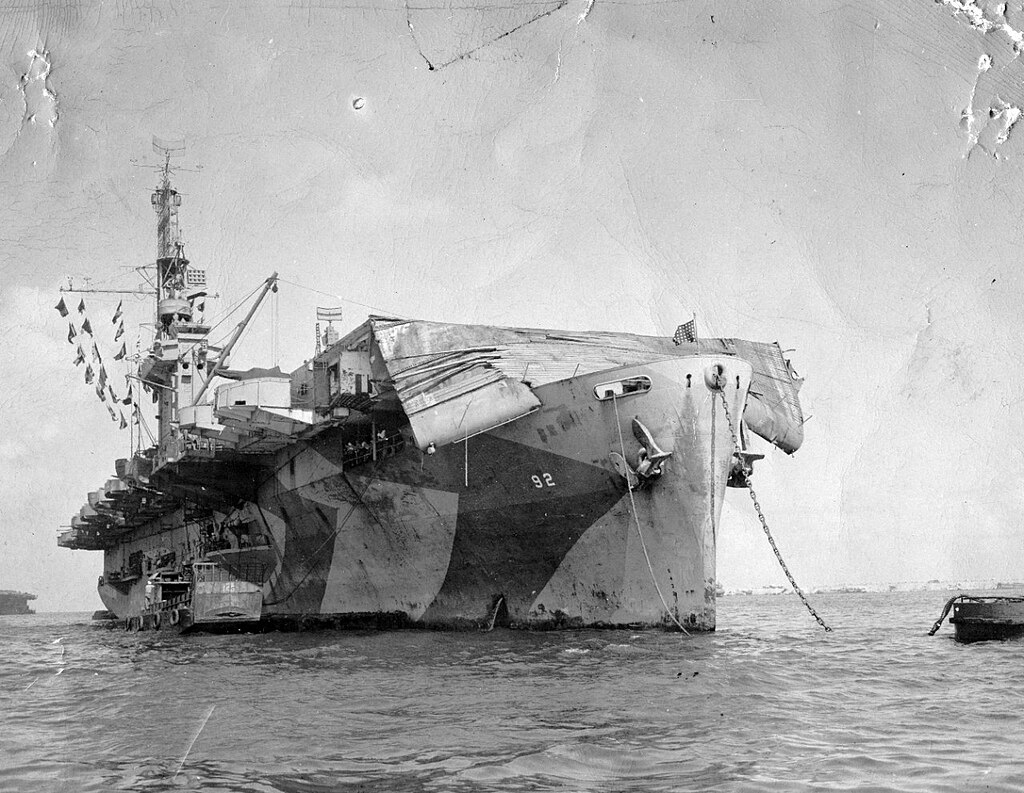 IWO JIMA (Twentieth Air Force): Mission 201: During the night of 11/12 Jun, 26 B-29s mine Shimonoseki Strait and Tsuruga Bay. Iwo Jima based fighters hit Tokorozawa Airfield; pilots attacking the airfield claim 18 parked airplanes destroyed and 30+ damaged. Combat crews of the 509th Composite Group begin to arrive at North Field with their B-29s. BORNEO CAMPAIGN (1945) In Borneo, B-24s support ground forces on Tarakan and bomb Kota Baru, Laoet Island, and Tawau; P-38s hit Beaufort while B-25s support ground forces in the Brunei Bay sector. Photo: USS LST-936, an unidentified LST and USS LST-806 beached at Labuan Island Borneo while offloading Royal Australian Air Force trucks, 11 June 1945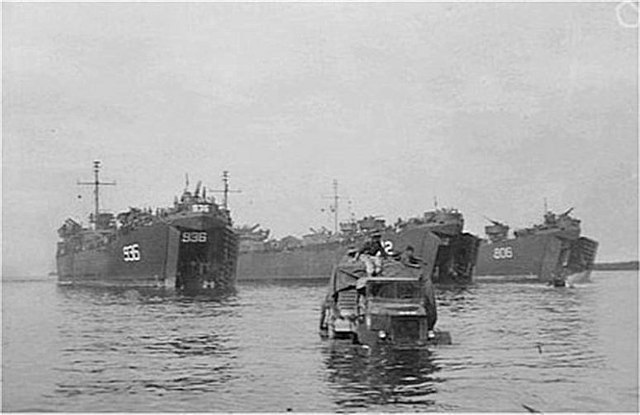 Photo: 25-pounders from the 2/7th Field Regiment, RAA, firing on Japanese positions on Tarakan, 11 June 1945 Photo: 25-pounders from the 2/7th Field Regiment, RAA, firing on Japanese positions on Tarakan, 11 June 1945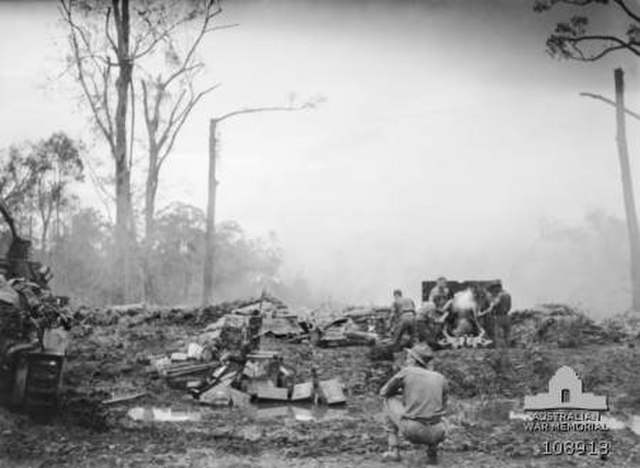 Photo: Soldiers from the 2/2nd Machine Gun company using a captured Japanese 7.7mm machine gun to attack Japanese positions on Joyce Feature, Tarakan, 11 June 1945 Photo: Soldiers from the 2/2nd Machine Gun company using a captured Japanese 7.7mm machine gun to attack Japanese positions on Joyce Feature, Tarakan, 11 June 1945 PHILIPPINE CAMPAIGN (1945) On Luzon, fighting at Orioung Pass continues as Japanese forces continue to hold the US 37th Division. On Luzon Island, B-25s, A-20s and fighter-bombers hit Cagayan Valley targets and pound forces E of Manila in the Ipo-Infanta areas and various targets N of Baguio; ground support strikes are flown in the Marikina River sector. VOLCANO AND RYUKYU ISLANDS CAMPAIGN On Okinawa, the Japanese pocket in the Oroku Peninsula has been reduce to perimeter measurable in yards but their resistance remains fanatical. An assault by the US 1st Marine Division (US 3rd Amphibious Corps) fails to capture Kunishi Ridge. A regiment of the US 96th Division reaches the town of Yuza but is forced to withdraw by intensive Japanese fire. An important height east of Mount Yaeju is capture by American forces. Off Okinawa, Japanese air attacks continue against ships on radar picket stations; large support landing craft LCS(L)(3)-122 is damaged when kamikaze crashes near her conning tower. Her commanding officer, Lieutenant Richard M. McCool, Jr., although wounded at the outset, releases men trapped in a burning compartment, suffering further injuries in so doing. For his courageously saving the lives of his men and inspiring his crew to save their ship, in addition to his actions the previous day in rescuing survivors of kamikazed destroyer William D. Porter (DD-579), McCool is awarded the Medal of Honor. Elsewhere off Okinawa, a kamikaze crashes alongside U.S. freighter Walter Colton; the ship receives additional damage from friendly fire of nearby ships in the anchorage. Of the combined complement of 41 merchant sailors, 29 Armed Guards and 11 Construction Battalion men, only three men suffer injuries. Dock landing ship Lindenwald (LSD-6) is also damaged by friendly fire, 26°17'N, 127°53'E. Okinawa-based PB4Y-2s (VPB 118) fly second aerial mining mission into the Korean archipelago, but fog, blanketing the entire objective, compels the Privateers to jettison the mines en route back to base. ALASKA (Eleventh Air Force): 8 B-24s on a shipping sweep over the Kurile Islands do not find targets because of overcast and instead radar-bomb installations on Kurabu Cape, Paramushiru Island and in the Kataoka areas of Shimushu. PACIFIC Cruisers and destroyers (Rear Admiral John H. Brown, Jr.) bombard Japanese installations on Matsuwa, Kurils. Twenty-six USAAF B-29s mine Shimonoseki Straits and the waters off Tsuruga, Japan. Japanese merchant cargo ship Hiwaka Maru is sunk by mine, 34°44'N, 125°52'E. Submarine Bowfin (SS-287) sinks Japanese merchant cargo ship No.3 Shinyo Maru off Genzan, Korea, 39°24'N, 128°59'E. Submarine Crevalle (SS-291) sinks Japanese gunboat No.5 Hakusan Maru off Henashi Zaki, Honshu, 40°43'N, 139°51'E. Submarine Flying Fish (SS-229) sinks Japanese army cargo ship Meisei Maru near Rashin, Korea, 41°47'N, 131°44'E. Submarine Sea Dog (SS-401) sinks Japanese merchant cargo ship Kofuku Maru, 40°28'N, 139°47'E. Submarine Segundo (SS-398) sinks Japanese merchant cargo ship No.2 Fukui Maru, in the Yellow Sea off the Shantung peninsula, 37°11'N, 123°23'E. Submarine Tirante (SS-420) sinks Japanese merchant cargo ship Hakuju Maru at Ha Jima, southern Kyushu, 42°37'N, 129°45'E. PB4Y-2 sinks Japanese auxiliary submarine chaser Cha 237 at entrance to Ise Bay, 34°30'N, 137°06'E; the explosion of the enemy patrol vessel, however, heavily damages the attacking Privateer. Japanese guardboat No.5 Nichiei Maru is sunk by U.S. aircraft southwest of Paramushiro, Kurils, 50°00'N, 155°00'E. Japanese cargo ship Kimi Maru is sunk by aircraft off west coast of Aomori prefecture.
|
|
lordroel
Administrator
Posts: 68,086 
Likes: 49,471
|
Post by lordroel on Jun 12, 2024 2:50:03 GMT
Day 2102 of World War II, June 12th 1945Netherlands Chinese Nationalist (KMT) general, Sun Liren inspected Canadian troops and captured German weapons at General Harry Crerar's headquarters in the Netherlands. ItalyYugoslavian forces withdraw from the disputed port of Trieste. The Yugoslavs urge the New Zealander and Indian troops to also pull out. United Kingdom Dwight D. Eisenhower received the Freedom of the City of London and the Order of Merit. Photo: The British Royal Navy destroyer HMS Camperdown (D32) at a buoy on the River Clyde on 12 June 1945 Photo: A mass of surrendered German U-boats at their mooring at Lisahally, Northern Ireland. There are nine of the 21 class (1600 tons carrying 23 torpedoes), four of the 9 class (500 tons) and thirty nine of the 7 class (also 500 tons), a total of fifty two U-boats, 12 June 1945 Photo: A mass of surrendered German U-boats at their mooring at Lisahally, Northern Ireland. There are nine of the 21 class (1600 tons carrying 23 torpedoes), four of the 9 class (500 tons) and thirty nine of the 7 class (also 500 tons), a total of fifty two U-boats, 12 June 1945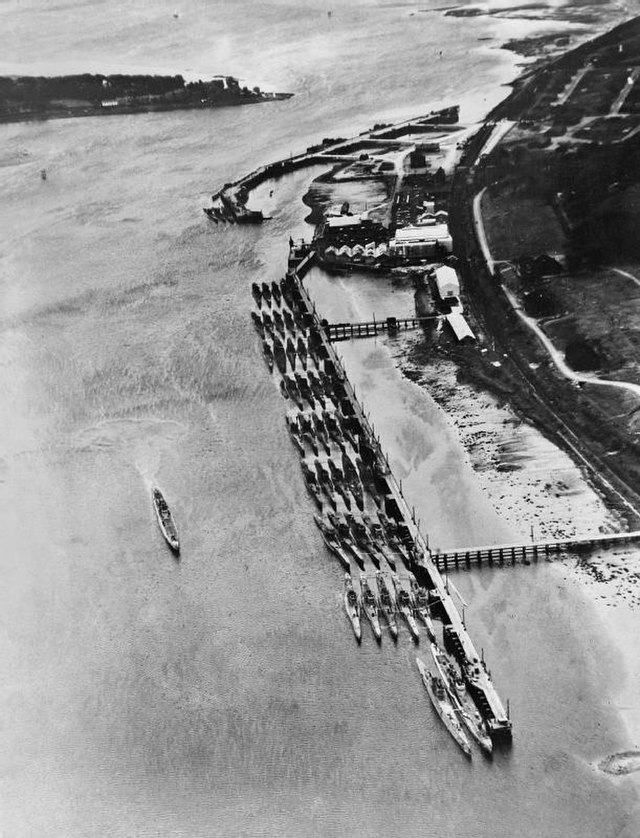 Pacific WarYouTube (Japan News No. 253- 21 June 1945 - English translation available) Pacific WarYouTube (Japan News No. 253- 21 June 1945 - English translation available)CHINA (Fourteenth Air Force): In China, 2 B-25s knock out a bridge S of Yutze while 4 escorting P-47s hit nearby AA positions and afterwards pound railroad targets at Linfen; 9 P-51s and 2 P-61s damage a bridge N of Hengyang, hit a storage area at Yunganshih, and attack railroad targets, troops, horses, AA positions, and road traffic in Neikiuhsien and Hengyang. GUAM (Seventh Air Force): 12 Guam Island-based B-24s pound the airfield on Marcus Island in the N Pacific. SOUTHWEST PACIFIC AREA B-24s inflict heavy destruction on the navy yard and dock area at Hong Kong and railroad yards at Saigon, French Indochina. 2 B-32s bomb the airstrip on Batan Island. BORNEO CAMPAIGN (1945) Borneo, numerous strikes on Tarakan the Brunei Bay area, and coastal routes in N Borneo. Photo: Troops from the Australian 2/43rd Infantry Battalion advance with a Matilda tank on Labuan. The soldier on the far right is carrying an Owen submachine gun, 12 June 1945 PHILIPPINE CAMPAIGN (1945) On Luzon, the US 145th Infantry Regiment breaks Japanese resistance at Orioung Pass, occupies the town of Orioung and advances as far as positions overlooking the town of Balite. The Visayan Islands (including Samar, Negros, Panay, Leyte, Cebu, and Bohol), between Luzon and Mindanao, are secured by American forces. American casualties in the campaign have amounted to 835 dead and 2300 wounded. Japanese casualties are estimated to be 10,000 dead. Numerous fighter-bombers and B-25s hit Cagayan Valley targets while other fighter-bombers support ground forces N of Baguio and Balete Pass and E of Manila, all on Luzon Island. VOLCANO AND RYUKYU ISLANDS CAMPAIGN On Okinawa, many of the Japanese naval infantry cut off in the Oruku peninsula, reduced to a pocket of about 1000 square yards, begin to commit mass suicide to avoid surrender. The US 1st Marine Division captures the west end of Kunishi Ridge during a night attack. The US 96th Division attacks Japanese positions around Mount Yuza and Mount Yaeju. Off Okinawa, light cruiser Vicksburg (CL-86) is damaged when own shell bursts as it leaves muzzle, 26°10'N, 127°20'E. Okinawa-based PB4Y-2s (VPB 118), using radar, mine the waters off Chin-To, Korean Archipelago. The same waters are mined again the following day. ALASKA (Eleventh Air Force): 4 B-25s strafe shipping off Paramushiru Island, near Arahata Cape, damaging 4 freighters and 2 barges; one of the B-25s is shot down. PACIFIC Submarine Sea Dog (SS-401) sinks Japanese merchant cargo ships Shinsen Maru and Kaiwa Maru, 40°11'N, 139°46'E. Submarine Skate (SS-305) sinks Japanese merchant cargo ships Yozan Maru, Kenjo Maru, and Zuiko Maru, and damages Kankyo Maru in Togi harbor, northern Honshu, 37°08'N, 136°42'E. Submarine Spadefish (SS-411) sinks Japanese guardboat Daido Maru west of Wakkanai, Hokkaido, 45°08'N, 141°10'E. Submarine Tinosa (SS-283) sinks Japanese merchant cargo ship Keito Maru, 37°30'N, 129°20'E. Japanese submarine chaser Ch 57 and passenger ferry No.2 Kuroshio (ex-landing ship T.149) are sunk by British destroyers HMS Tartar, HMS Eskimo, and HMS Nubian (10th Destroyer Flotilla), 20 miles north ofSabang, Sumatra, 06°20'N, 94°45'E, as the enemy is engaged in withdrawing his troops from the Andamans. Japanese auxiliary submarine chaser Myoken Maru is sunk by aircraft, Atsuta dockyard. Mines laid by USAAF B-29s sink Japanese army cargo ship Aizan Maru in Hakata Bay, 33°38'N, 130°22'E, merchant cargo ships Sagami Maru, 25 miles off Kaburazaki, and Fumitsuki Maru off Shirasu, 33°57'N, 130°44'E, and liaison ship Shimonoseki Maru at 36°30'N, 130°19'E, and damage army tanker Yamadono Maru, 2.5 kilometers off Manabe Island.
|
|
lordroel
Administrator
Posts: 68,086 
Likes: 49,471
|
Post by lordroel on Jun 13, 2024 2:50:02 GMT
Day 2103 of World War II, June 13th 1945United StatesU.S. Army ordnance experts claimed that German plans to attack the United States with V-2 rockets might have been realized by November 1945 if the war had gone on that long. Soviet UnionSoviet Politburo ordered trials for a number of war time Polish leaders, including those who headed up the anti-German Home Army. Pacific War CHINA (Fourteenth Air Force): In China, 11 B-25s and 7 P-51s considerably damage the Kaifeng railroad yards and strafe a communications center S of Puchou; 8 P-51s damage 2 bridges at Fenglochen and Shihkiachwang and hit railroad targets of opportunity around Fenglochen and Suchow. Japanese forces prepare to evacuate Liuchow and Kweilin. GUAM (Seventh Air Force): 13 B-24s from Guam bomb Moen Airfield. TINIAN (Twentieth Air Force): Mission 202: During the night of 13/14 May, 29 B-29s drop mines in Shimonoseki Strait and in the waters at Niigata. 40+ P-47s from Ie Shima strafe and fire rockets at vessels, buildings, a radio station, barracks, and airfields at Amakusa Jima and Amami-O-Shima Islands, and Tokuno, Japan. SOUTHWEST PACIFIC AREA [Far East Air Force]: In Formosa, bad weather hinders B-24s; a few hit Toshien, the primary target and others hit alternates including Toko, Koshun, Kontei, Garan-bi Point, Taito, the Mako naval base and other targets and 2 B-32s bomb Koshun Airfield. BORNEO CAMPAIGN (1945) On Borneo, Australian forces enter the city of Brunei. Photo: Troops of 2/17 Infantry Battalion, moving into Brunei Township during the Oboe 6 Operation Photo: Australian soldiers of the 2/17th Battalion patrolling Brunei Town Photo: Australian soldiers of the 2/17th Battalion patrolling Brunei Town 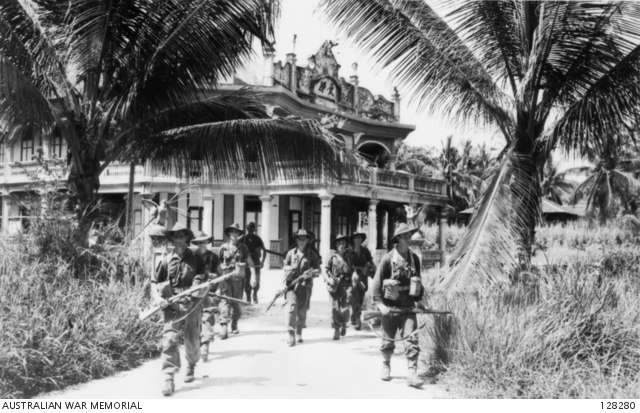 Photo: An Australian 2/43rd Battalion Bren Gun position on Labuan Island to the north of the airfield during the fighting on the island, 13 June 1945 Photo: An Australian 2/43rd Battalion Bren Gun position on Labuan Island to the north of the airfield during the fighting on the island, 13 June 1945 In Borneo, B-24s bomb the Balikpapan-Sepinggang area; B-25s and fighter-bombers support ground forces in the Brunei Bay area and, sweeping N Borneo from Kudat to Miri, hit numerous targets of opportunity. PHILIPPINE CAMPAIGN (1945) On Luzon, an American armored column attempts pass through the Orioung Pass, to exploit a breakthrough achieved by the US 145th Infantry Regiment (US 37th Division), but a Japanese counterattack blocks the road. On Luzon Island, A-20s and fighter-bombers attack the Cervantes and Marikina areas, targets in the Cagayan Valley, and islands N of Luzon. VOLCANO AND RYUKYU ISLANDS CAMPAIGN On Okinawa, the Japanese resistance in the Oruku peninsula ends. The US 6th Marine Division records a record 169 Japanese prisoners as well as finding about 200 dead. (This is a large total when compared with previous numbers of Japanese prisoners reported.) The fighting continues to the southeast, especially in the Kunishi Ridge area where a regiment of the US 1st Marine Division suffers heavy casualties. The US 24th Corps uses armored flamethrowers in the elimination of the Japanese held fortified caves on Mount Yuza and Mount Yaeju and on Hills 153 and 115. Photo: A soldier in a Yank half track looks at a demolished plane, a Japanese twin engine bomber, 13 June 1945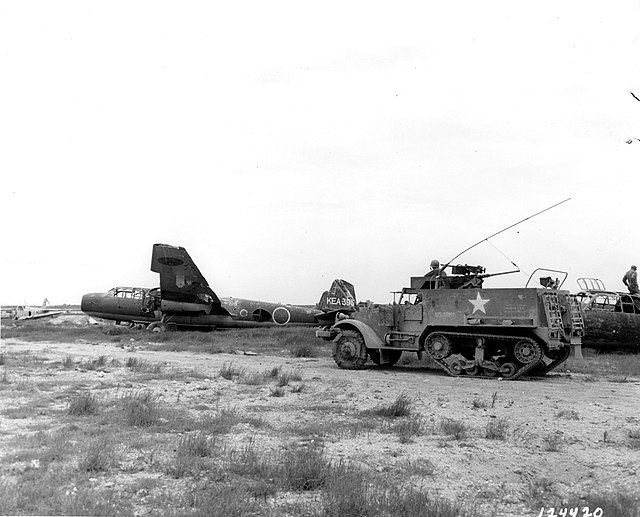 Off Okinawa, battleship Idaho (BB-42) is damaged by grounding, 26°14'N, 127°57'E. PACIFIC Large infantry landing craft LCI(L)-871, on routine patrol along the east coast of Urukthapel Island Palaus, engages Japanese artillery and mortar batteries. Twenty-nine USAAF B-29s (20th Air Force) mine Shimonoseki Straits and the waters off Niigata, Japan. Mines laid in these and previous plants by B-29s sink merchant cargo ship Matsuo Maru, 3.4 kilometers south of Motoyama light, and Hiyoshi Maru and No.8 Nissho Maru off Hesaki light, 33°54'N, 131°07'E, Koryu Maru off Hesaki light, 33°55'N, 131°07'E, and damage escort destroyer Io, 1.7 kilometers southeast of Kannonzaki, and merchant cargo ships Kinyo Maru, Kyokenzaki, Kammon Strait, Kannon Maru (unspecified location), Hakujitsu Maru at 33°5837'N, 130°44'E, Takakurasan Maru at 37°07'N, 137°03'E, and 2 Kofuku Maru, 37°07'N, 137°03'E. Submarine Bergall (SS-320) is damaged by mine (U.S. or British proximity-fuzed) in Gulf of Siam, 11°45'N, 99°50'E, and is forced to terminate her patrol. Submarine Bonefish (SS-223) sinks Japanese cargo ship Oshikasan Maru in Japan Sea, 38°30'N, 136°58'E. Submarine Bowfin (SS-287) sinks Japanese merchant cargo ship Meiho Maru, 39°00'N, 128°05'E. Submarine Skate (SS-305) sinks Japanese merchant cargo ship Hattenzan Maru, 37°20'N, 134°28'E. Submarine Spadefish (SS-411) mistakenly sinks Russian cargo ship Transbalt, 45°44'N, 140°48'E. Japanese merchant cargo ship Kaisho Maru is sunk by aircraft, 35°49'N, 126°23'E. Mines laid by USAAF B-24s (14th Air Force) sink Japanese merchant cargo ship Koun Maru off Macao, 23°30'N, 113°30'E.
|
|
lordroel
Administrator
Posts: 68,086 
Likes: 49,471
|
Post by lordroel on Jun 14, 2024 6:16:32 GMT
Day 2104 of World War II, June 14th 1945Allied occupied GermanyIn Hamburg, British troops capture the former Nazi foreign minister, Joachim von Ribbentrop, in a boardinghouse. France Gen. of the Army Dwight D. Eisenhower was decorated by Gen. Charles De Gaulle with the French Order of Liberation at the Arc de Triomphe. Ike later gave a speech at the Hotel de Ville, Paris attended by all senior military and civilian officials in the city. United StatesThe US Joint Chiefs of Staff issue a directive to General MacArthur, General Arnold and Admiral Nimitz to prepare plans for the immediate occupation of the Japanese islands in the event of a sudden capitulation. This order may have been given in light of recent progress on the production of an atomic bomb but this is not stated. SwedenPhoto: Soviet POWs before boarding at Fredriksskans, Gävle to return back to the Soviet Union, 14 June 1945 Pacific War Pacific War CHINA Otozo Yamada met with his top Kwangtung Army officers in Xinjing (Changchun), China to plan defenses against a potential Soviet invasion. (Fourteenth Air Force): In China, 42 P-51s attack bridges, shipping, AA positions, railroad targets, trucks, and communications around Hengyang, Hankow, Yoyang, Lingling, Anyang, Szeshui, Hohsien, Shihkiachwang, Neikiuhsien and Puchou. Chinese forces capture the city of Ishan from Japanese forces after a five-day battle. The Chinese forces pursue the Japanese towards Liuchow. CAROLINE ISLANDS British TG 111.2 (Rear Admiral Eric J.P. Brind, RN), comprising fleet carrier HMS Implacable, escort carrier HMS Ruler, four light cruisers and five destroyers, attacks Truk atoll to neutralize Japanese air bases there. BORNEO CAMPAIGN (1945) B-24s bomb AA positions at Balikpapan, Borneo. Photo: Private B K F Collyer, B Company 2/17 Infantry Battalion, moving along the main road on the outskirt of the town, In the foreground is a Japanese 20MM Twin Barrel Dual Purpose Gun, 14 June 1945 PHILIPPINE CAMPAIGN (1945) On Luzon, American forces dislodge the Japanese blocking the Orioung Pass. Elements of the US 37th Division, formed into an armored column, advance as far as Echague. From Santiago, other units advance toward Cabanatuan and Cauayan. On Luzon Island, B-25s, A-20s, and fighter-bombers pound areas around the Cagayan Valley, Cervantes and N of Baguio and E of Manila. On Celebes Island, B-24s bomb warehouses at Parepare and a personnel area at Sidate. The air echelon of the 25th Photographic Reconnaissance Squadron, 6th Reconnaissance Group, begins operating from Clark Field, Luzon with F-5s (squadron is based at San Jose, Mindoro Island). VOLCANO AND RYUKYU ISLANDS CAMPAIGN On Okinawa, mopping up operations proceed on the Oroku peninsula. The troops of the US 3rd Amphibious Corps and the US 24th Corps continue to eliminate fortified caves held by Japanese forces on Kunishi Ridge and on Mount Yuza and Mount Yaegu. An American regiment of the US 96th Division reaches the summit of Mount Yaegu, while the US th Division extends its control of Hills 153 and 115. Photo: Riflemen of the 2nd Bn., 381st Regiment of the Tenth Army's 96th Div. peer cautiously ahead as they advance across the summit of Yaeju-Dake escarpment (Big Apple Ridge) on Okinawa. 14 June 1945 PACIFIC Motor gunboat PGM-24 is damaged when accidentally rammed by light minelayer Thomas E. Fraser (DM-24) off Okinawa, 25°30'N, 126°00'E. Submarine Sea Devil (SS-400), despite presence of two escorts, sinks Japanese transport Wakamiyasan Maru in the northern Yellow Sea, 37°35'N, 123°30'E. Submarine Spadefish (SS-411) sinks Japanese merchant cargo ship Seizan Maru off western Sakhalin, 47°03'N, 142°01'E. PB4Y-2s (VPB 118), flying from Okinawa, mine waters between Gyuji-To, Toso-To and Jobai-To, Korean Archipelago, encountering antiaircraft fire from nearby anchored shipping. The same waters are mined each day over the next three days, but the Privateers encounter no further antiaircraft fire on those occasions. Mine laid by USAAF B-29s sinks Japanese army cargo ship No.18 Umajima Maru at 33°39'N, 130°15'E. PB4Y bombs Japanese shipping off Bandjermasin, sinking No.470 Shuttle Vessel.
|
|
lordroel
Administrator
Posts: 68,086 
Likes: 49,471
|
Post by lordroel on Jun 15, 2024 13:59:10 GMT
Day 2105 of World War II, June 15th 1945YouTube (Mao Tightens His Grip)United Kingdom Parliament is dissolved by King George VI, in anticipation of the first general election since 1935. United StatesPhoto: The U.S. Navy destroyer USS Gatling (DD-671) departing the Mare Island Naval Shipyard, California (USA), on 15 June 1945 Photo: The U.S. Navy destroyer USS Clarence K. Bronson (DD-668) off the Mare Island Naval Shipyard, California (USA), on 15 June 1945 Photo: The U.S. Navy destroyer USS Clarence K. Bronson (DD-668) off the Mare Island Naval Shipyard, California (USA), on 15 June 1945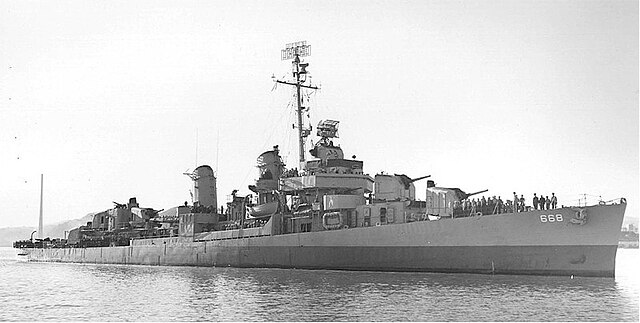 Pacific War Map of the Pacific as of 15 June 1945 Pacific War Map of the Pacific as of 15 June 1945 CHINA (Fourteenth Air Force): In China, 3 B-25s and 47 P-51s and P-47s knock out a bridge W of Shihkiachwang, damage and attack others, and hit trucks, barracks, river-craft, storage facilities, gun positions, railroad targets, and targets of opportunity; targets are the Pinghan railroad, Kukong, Lingling, Chenhsien, Kuotaichiao, Pakonghow, Kweilin, Anyang, Shihkiachwang, Loyang, Liuchow, and Paoching areas. Chinese forces advance along a broad front in Kwangsi Province. CAROLINE ISLANDS British TG 111.2 (Rear Admiral Eric J.P. Brind, RN), bombards Japanese installations, Truk atoll. TINIAN (Twentieth Air Force): 2 missions are flown: Mission 203: 444 B-29s fly an incendiary mission against the Osaka- Amagasaki urban area, ending a month of concentrated fire raids against large Japanese cities; an additional 1.9 square miles of Osaka and 0.59 square miles of Amagasaki are burned out; 25 other B-29s hit alternate targets; 2 B-29s are lost. 123 P-51s are dispatched as escort but 380 miles from Iwo Jima the fighters are warned by a weather plane of a towering front over Japan and they abort the mission; 1 P-51 is lost. Mission 204: During the night of 15/16 May, 30 B-29s mine Shimonoseki Strait and waters around Fukuoka, Karatsu, and Fushiki. The 680th Bombardment Squadron (Very Heavy), attached to HQ 504th BG (Very Heavy), arrives at North Field from the US with B-29s. SOUTHWEST PACIFIC AREA [Far East Air Force]: In Formosa, B-24s bomb Taichu Airfield and B-25s hit the town of Rokko and the airfield at Okaseki. The 68th Troop Carrier Squadron, 433d Troop Carrier Group, moves from Tanauan, Leyte Island to Clark Field, Luzon with C-46s. BURMA Mountbatten addresses the victory parade in Rangoon. American OSS units complete mopping up operations in the Shan Mountains area. BORNEO CAMPAIGN (1945) The Australian 9th Division met no opposition when it landed at Brunei Bay and on Labuan and Muara islands, after a heavy air and naval bombardment, five days ago. Brunei Bay is the best harbour on the north-west coast of Borneo, and the US chiefs of staff proposed it as an advance base for the British Pacific Fleet. The British argued that it was too far from the main theatre of operations and was in any case unlikely to be ready in time. Developing the naval base would be a waste of construction effort, they said, especially as it could not be made ready until the end of the year - and by then Singapore might have been recaptured. The operation has gone ahead nonetheless, using Australian troops supported by the US Seventh Fleet and the Royal Australian First Tactical Air Force. A brigade of the 9th Division quickly occupied Labuan Island and secured the port on 10 June. By the end of the day it had also occupied the airport. Surviving Japanese withdrew into a pocket. Advancing against slight resistance, the Australians captured Brunei Town on 13 June and today reported the capture of the islands of Labuan and Muara. Fifteen motor minesweepers (YMS), accompanied by the high speed transport Cofer (APD-62) and landing craft equipped with light minesweeping gear, arrive off Balikpapan, Borneo, to begin mine clearance operations. B-24s blast gun positions at Balikpapan and B-25s and P-38s hit areas between Brunei and Kudat. PHILIPPINE CAMPAIGN (1945) On Luzon, Filipino guerrillas seize Cervantes in the north. Meanwhile, the US 37th Division continues to battle forward in the Cagayan valley, eliminating a Japanese strong point about 3 miles from Santiago, near Cabanatuan. On Luzon Island, numerous B-25s, A-20s, and fighter-bombers pound various objectives, concentrating on the Cagayan Valley, the Cervantes area, and the Antipolo-Ipo sector. VOLCANO AND RYUKYU ISLANDS CAMPAIGN On Okinawa, Marines suffer heavy casualties and are unable to advance on Kunishi Ridge. The US 1st Division, already short of troops, is attached to the US 2nd Marine Division. Forces of the US 24th Corps continue operations to eliminate Japanese positions on Mount Yaeju and Mount Yuza. Photo: Tenth Army doughboys of the 96th Division approach the top of Big Apple Hill, heavily fortified position, captured during an intense battle with Japanese troops on 15 June 1945 Photo: 2nd Bn., 7th Div. OP on side of many coral rocks approaching Hill 153. 15 June, 1945 Photo: 2nd Bn., 7th Div. OP on side of many coral rocks approaching Hill 153. 15 June, 1945 PACIFIC Thirty USAAF B-29s mine Shimonoseki Straits and the waters off Fushiki, Fukuoka, and Karatsu, Japan. Destroyer escort O'Flaherty (DE-340) is damaged in collision with escort carrier Block Island (CVE-106) off Okinawa, 26°00'N, 128°00'E. Submarine Sea Dog (SS-401) sinks Japanese merchant cargo ship Koan Maru, 39°53'N, 139°40'E. Japanese guardboats Gion Maru and Jinko Maru are sunk by U.S. aircraft, Cam Ranh Bay, French Indochina. Japanese freighter No.2 Tanshin Maru is sunk by marine casualty, near Malay peninsula. USAAF B-24s (10th Air Force) attack Japanese convoy in Gulf of Siam, damaging destroyer Kamikaze and minesweeper W.4 and sinking merchant tanker Toho Maru off Samui Island 09°25'N, 99°54'E, Japanese merchant cargo ship Heiryu Maru sinks after colliding with submerged wreck southwest of Shinshin Island Korea, 36°39'N, 126°07'E. Japanese cargo vessel Junkawa Maru is sunk by mine, 04°41'S, 106°13'E.
|
|
lordroel
Administrator
Posts: 68,086 
Likes: 49,471
|
Post by lordroel on Jun 16, 2024 6:19:17 GMT
Day 2106 of World War II, June 16th 1945Allied occupied GermanyAmerican troops captured the former Hungarian Prime Minister Béla Imrédy. BelgiumBelgian Premier Achille van Acker and his cabinet resign in protest against the contemplated return of King Leopold III. Pacific War CHINA (Fourteenth Air Force): In China, 2 B-25s hit supply movements on the Paoching-Hengyang road; 41 P-51s attack bridges, shipping, road transport, power facilities, and railroad traffic, knocking out bridges near Siangtan, Changsha, and Suchow; rail, road and river traffic is attacked near Yoyang, Hengyang, Kuanyang, Shou-yang, Peking, and Linfen. A power plant at Uong Bi, French Indochina is heavily damaged. IWO JIMA (Twentieth Air Force): P-61s arrive on Ie Shima and take over night heckler missions against Kyushu Island, Japan from the P-47s; other P-61s fly night intruder missions over Amami Gunto Island, Japan, bombing various targets of opportunity; 38 P-47s from Ie Shima dive-bomb boats, AA positions, runways, and buildings on Kikai Island, Japan. SOUTHWEST PACIFIC AREA [Far East Air Force]: On Formosa, 90+ B-24s pound Kiirun harbor and the town of Takao and 3 B-32s bomb Taito. HQ 308th Bombardment Wing moves from Luzon to Okinawa Island. CAROLINE ISLANDS British naval units bombard the Japanese base at Truk. BORNEO CAMPAIGN (1945) In Borneo, B-24s bomb Balikpapan gun emplacements, Tawau, and Samarinda, while B-25s hit the Brunei Bay area and fighter-bombers attack Miri, Jesselton, and Keningau Airfields and N Borneo targets of opportunity. PHILIPPINE CAMPAIGN (1945) On Luzon Island, B-25s, A-20s, and fighter-bombers hit personnel and supply targets in the Cagayan Valley and E of Manila, and support ground forces in the Cervantes sector. VOLCANO AND RYUKYU ISLANDS CAMPAIGN On Okinawa, Mount Yuza is captured by the US 381st Infantry Regiment. Fighting continues on the south of the island. Photo: Soldiers of the 32nd Regt., 7th Inf. Div., advancing to Hill 115 against moderate resistance. 16 June, 1945 Off Okinawa at 2030 hours local, a single, low-flying Japanese aircraft drops a torpedo which hits the destroyer USS Twiggs on her port side, exploding her number 2 magazine. The plane then circles and completes its kamikaze mission in a suicide crash. The explosion enveloped the destroyer in flame; and, within an hour, she sinks. Despite the hazard of exploding ammunition, 188 survivors are rescued from the oily waters; among the 162 dead and missing is her commanding officer. Photo: The crew of one of the port forward 20 mm guns aboard the U.S. Navy destroyer minelayer USS Lindsey (DM-32) pose by their weapon, at Guam, circa 16 June 1945. They had stuck to their post until knocked off their feet by the force of a second explosion, when Lindsey was struck by two Kamikaze planes off Okinawa on 12 April 1945. Note the severely damaged plating in the vicinity Photo: The U.S. Navy escort carrier USS Kula Gulf (CVE-108) launches a Grumman F6F-5 Hellcat. This was the first catapult launch of the newly commissioned carrier, 16 June 1945 Photo: The U.S. Navy escort carrier USS Kula Gulf (CVE-108) launches a Grumman F6F-5 Hellcat. This was the first catapult launch of the newly commissioned carrier, 16 June 1945 ALASKA (Eleventh Air Force): In the Kurile Islands, 4 B-24s bomb and strafe shipping off Suribachi Bay, Paramushiru Island and a radar site on Minami Cape, Shimushu Island; one of the B-24s crashes into the water; 4 B-25s on a shipping strike score near misses on a freighter in Asahi Bay and bomb targets along the Torishima Chain; mechanical failures force 2 of the B-25s to fly to Petropavlovsk, USSR. PACIFIC Submarine Piranha (SS-389) sinks Japanese merchant cargo ship Eiso Maru, 41°57'N, 140°56'E. British submarine HMS Taciturn sinks Japanese auxiliary submarine chaser Cha 105 and unnamed air warning picket hulk (ex-Dutch submarine K-XVIII) off Surabaya, Java, N.E.I. Japanese auxiliary submarine chaser Wakatake Maru is sunk by aircraft, Keelung harbor. Japanese army cargo ship Taikyu Maru is sunk by mine west of the mouth of Kammon channel. Japanese merchant cargo ship Takeshima Maru is sunk by aircraft, 34°35'N, 125°58'E. Japanese merchant cargo ship Kinsho Maru is sunk, agentand location unspecified. Japanese merchant cargo ship No.35 Banshu Maru is sunk by mine, 33°57'N, 130°43'E. Japanese destroyer Natsuzuki is damaged 3.1 kilometers off Mutsure Island.
|
|
lordroel
Administrator
Posts: 68,086 
Likes: 49,471
|
Post by lordroel on Jun 17, 2024 2:46:24 GMT
Day 2107 of World War II, June 17th 1945Soviet Union Lavrentiy Beria gathered the conclusive evidence of Adolf Hitler's death and reported this to Joseph Stalin. Pacific War CHINA (Fourteenth Air Force): In China, 2 B-25s bomb road and rail supply movements in the Paoching and Hengyang areas; 2 B-25s and 4 P-47s severely damage a bridge at Linmingkuan; 54 P-51s, P-47s, and P-61s hit road transport, railroad, river traffic, gun positions, bridges, and targets of opportunity around Kukong, Hankow, Lingkuantien, Changsha, Yoyang, Loyunghsien, Luchai, Hwangshapu, Kiyang, Kweilin, Kaifeng, and Shihkiachwang; and 4 P-47s blast a communications center at Puchou. General Arnold orders General Chennault to be replaced by General Stratemeyer as Commander in Chief of the US air forces operating in China. Japanese troops in southern China begin withdrawing northward in five long columns between the Yellow and Yangtze rivers. TINIAN HQ AAF (Twentieth Air Force): 1 mining and 4 incendiary missions are flown during the night of 17/18 Jun. Mission 205: 25 B-29s mine Shimonoseki Strait and waters around Kobe; 2 others mine alternate targets. Mission 206: 117 B-29s attack the Kagoshima urban area and 1 hits an alternate target; 2.15 square miles are destroyed; 1 B-29 is lost. Mission 207: 116 B-29s hit the Omuta urban area and 3 hit alternate targets; the was the heaviest attack of the 5 but only 0.217 square miles were destroyed, only 4.1% of the city's area. Mission 208: 130 B-29s hit the Hamamatsu urban area; 2.44 square miles are destroyed. Mission 209: 89 B-29s attack the Yokkaichi urban area; 1.23 square miles are destroyed. 33 P-47s from Ie Shima bomb and strafe shipping, the airfield,villages, a bridge and radar and radio facilities on Amami Gunto Island and Tokuno, Japan. During the night of 17/18 Jun, 2 P-61s from Ie Shima Island fly an unsuccessful (due to weather) intruder strike over Amami Gunto and Kyushu, Japan; this begins a campaign of night and day intruder missions over Kyushu and the Ryukyu Islands by the night fighters (12 more are flown during Jun). SOUTHWEST PACIFIC AREA [Far East Air Force]: On Formosa, B-24s bomb industrial and railroad targets at Kiirun and P-38s pound a railroad bridge and trucks at Soton. The detachment of the 550th Night Fighter Squadron, XIII Fighter Command, operating from Zamboanga with P-38s, P-61s and P-70s, returns to base at Tacloban detachment are at Sanga Sanga and Puerto Princessa). BORNEO CAMPAIGN (1945) In Borneo, B-24s pound Balikpapan area oil targets and gun positions; B-25s and P-38s hit Limbang town and sweep from Beaufort to Jesselton, hitting Beaufort buildings, several communications targets at various points, and personnel areas on Labuan Island. Photo: Wing Commander K E H Kay, RAF, British Borneo Civil Affairs Unit (3) Greeting the Sultan of Brunei (2) and his wife (1) on thier arrival at the wharf after thier journey from the from the village of Tentayer whence they fled during the bombing of Brunei, 17 June 1945 Photo: The Sultan of Brunei (2) and his wife (1) accompanied by Wing Commander K E H Kay, RAF, British Borneo Civil Affairs Unit (3) moving up the bank from the wharf on their arrival back in the area from the village of Tentayer whence they fled during the bombing of Brunei, 17 June 1945 Photo: The Sultan of Brunei (2) and his wife (1) accompanied by Wing Commander K E H Kay, RAF, British Borneo Civil Affairs Unit (3) moving up the bank from the wharf on their arrival back in the area from the village of Tentayer whence they fled during the bombing of Brunei, 17 June 1945 Photo: Native Dyaks from the mainland of Boerneo, walking along a Brunei Street, armed with Japanese rifles. They are on their way to their villages in the hills, 17 June 1945 Photo: Native Dyaks from the mainland of Boerneo, walking along a Brunei Street, armed with Japanese rifles. They are on their way to their villages in the hills, 17 June 1945 PHILIPPINE CAMPAIGN (1945) On Luzon, elements of the US 37th Division, US 1st Corps, captures Naguilian after making a forced crossing of the Cagayan river, near the town of Cagayan. On Luzon Island, B-25s, A-20s, and fighter-bombers pound Cagayan Valley targets and numerous other objectives throughout N Luzon; many of the strikes support US Sixth Army forces. VOLCANO AND RYUKYU ISLANDS CAMPAIGN On Okinawa, reinforced American units advance in the Kuishi Ridge area which has been stubbornly defended by forces of the Japanese 32nd Army. Along the line of the US 24th Corps, the last Japanese defensive line is broken. The US 7th Division completes the capture of Hills 153 and 115. The commander of the Japanese naval base on Okinawa, Admiral Minoru Ota, is found dead, having committed suicide. HQ AAF (XX Bomber Command): HQ XX Bomber Command begins a movement from Kharagpur to Okinawa. ALASKA (Eleventh Air Force): 4 B-25s bomb shipping near Kataoka, Shimushu; one ship (KONGO MARU) is observed exploding, another burns after a strafing run; 4 other B-25s fly a shipping sweep from Shimushu to Kurabu Cape, Paramushiru Island; a number of vessels are sighted but cannot be attacked because of land-based AA. PACIFIC Twenty-seven USAAF B-29s mine Shimonoseki Straits and the waters off Kobe, Japan. Gasoline tanker Chestatee (AOG-49) is damaged in collision with U.S. tanker Sinclair Superflame off Luzon, 07°04'N, 122°06'E. Submarine Spadefish (SS-411) attacks Japanese convoy, sinking Japanese auxiliary minelayer Eijo Maru off Matsuta Misaki, Hokkaido,, 42°38'N, 139°49'E. Submarine chaser PC-794 is damaged when she strikes an uncharted rock off Theodore Point, Otter Island Alaska, 52°45'10"N, 172°53'20"E. Japanese cargo ship Kongo Maru is sunk by aircraft, north of Shumushu Island. Japanese fast transport T.16 is damaged by aircraft, 15 miles off Oshima. Japanese Coast Defense Vessel No.46 is damaged by marine casualty north of Tsingtao, China. Japanese naval vessel Bingo Maru is damaged by marine casualty, two kilometers off Paekyongdo. Japanese merchant cargo ship Jintsugawa Maru is sunk by marine casualty off Najin, Korea.
|
|
lordroel
Administrator
Posts: 68,086 
Likes: 49,471
|
Post by lordroel on Jun 18, 2024 2:47:39 GMT
Day 2108 of World War II, June 18th 1945Soviet occupied Germany General Nikolai Berzarin, the Soviet commander in Berlin, Germany, was killed in a car crash in the city. Soviet Union Sixteen officers of the Polish Home Army are put on trial for fighting the Red Army. Photo: The show trial of 16 leaders of Polish wartime underground movement (including Home Army and civil authorities) convicted of "drawing up plans for military action against the U.S.S.R.", Moscow, June 1945. They had been invited to help organize the new "Polish Government of National Unity" in March 1945 and captured by NKWD. Despite the court's conspicuous leniency, only two were still alive six years later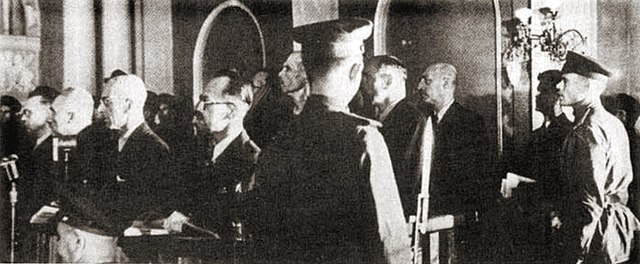 United States United StatesGeneral Eisenhower addresses a joint session of Congress as he begins a series of victory celebrations in his honor. United KingdomWilliam Joyce, Lord Haw Haw, is put on trial for treason in London, for broadcasting propaganda from Germany. The armed services begin demobilizing at a rate of 30,000 people per week. The British demobilization began. Photo: "demob" (Females) Farewell at Royal Naval Air Station, Henstridge, Somerset, 18 June 1945 Photo: "demob" (Males) Farewell at Royal Naval Air Station, Henstridge, Somerset, 18 June 1945 Photo: "demob" (Males) Farewell at Royal Naval Air Station, Henstridge, Somerset, 18 June 1945 Pacific War Pacific WarCHINA (Fourteenth Air Force): 70+ P-51s, P-61s, and P-47s continue to disrupt the Japanese withdrawal from S and E China, attacking bridges, villages and town areas, barracks, troop concentrations, motor transport, shipping and rail traffic, and targets of opportunity throughout wide areas. Chinese forces capture the port of Wenchow. JAPAN On instructions from Emperor Hirohito, Prime Minister Suzuki tells the Japanese Supreme Council that it is the intention of Hirohito to seek peace with the Allies as soon as possible. American bombers begin a series of 23 raids against major Japanese cities, all with populations between 100,000 and 350,000 people. SOUTHWEST PACIFIC AREA In Formosa, B-24s destroy a block of buildings and several warehouses and small vessels in Kiirun harbor area, P-51s hit Taien and Toyohara Airfields and targets of opportunity while P-38s start numerous fires in the town of Kari. BORNEO CAMPAIGN (1945) On Borneo, Australians reach Tutong in Brunei. In Borneo, B-24s blast troop concentrations in Balikpapan and S of Miri, Manggar Airfield and Sepinggang defenses and B-25s support ground forces on Labuan Island. PHILIPPINE CAMPAIGN (1945) On Luzon, elements of the US 37th Division, supported by an armored column, advance in the Caygayan valley, capturing Ilagan airfield and crossing the Ilagan River. On Mindanao, organized Japanese resistance comes to an end. Forces of the Japanese 35th Army have been cut off and dependent on roots and tree bark for food for some time now. Nonetheless, some small units of Japanese continue to resist. On Luzon Island, B-25s, A-20s, and fighter-bombers continue to attack targets in the Cagayan Valley, Balete Pass, and Cervantes areas, and other locations. VOLCANO AND RYUKYU ISLANDS CAMPAIGN On Okinawa, the remnants of the Japanese 32nd Army continue to offer determined resistance to attacks of the US 3rd Amphibious Corps and the US 24th Corps. Photo: US forces hiding behind a Tomori Stone Lion, 18 June 1945 Lt. General Simon Bolivar Buckner, commanding US 10th Army, is killed by Japanese artillery fire while he is on a visit to the front line, inspecting troops of the US 8th Marine Division. He is temporarily replaced by General Geiger, commanding the US 3rd Amphibious Corps. Photo: This is the last photograph taken of Lt. Gen. Simon B. Buckner, Jr., USA, right, just before he was killed on 18 June, observing the 8th Marines in action on Okinawa for the first time since the regiment entered the lines in the drive to the south. Note the rock and coral outcropping to his left. The shell that exploded hit that outcropping, dispersing fragments into the general, killing him within a few minutes. The other two staff officers were not seriously hurt ALASKA (Eleventh Air Force): 6 B-24s join US Navy aircraft in attacking Kataoka, Shimushu and Tomari Cape, Paramushiru Island; cloud cover prevents observation of effects; 1 B-24 flies a radar-ferret mission over the Kurile Islands. PACIFIC Battleship Nevada (BB-36) and two destroyers (Captain Homer L. Grosskopf), en route from Pearl Harbor to Saipan, bombards shore installations on Emidj Island, Jaluit Atoll, Marshalls, coordinated with bombing by land-based planes from U.S. bases in the Marshalls. Rear Admiral Forrest B. Royal, Commander, Amphibious Group 6, dies on board amphibious force flagship Rocky Mount (AGC-3) of coronary thrombosis. Motor minesweeper YMS-50, damaged by mine off Balikpapan, Borneo, 01°18'S, 116°49'E, is scuttled by light cruiser Denver (CL-58). Submarine Apogon (SS-308), attacking Japanese convoy RU, sinks transport Hakuai Maru and guardboat No.2 Kusonoki Maru southwest of Paramushiro, Kurils, 50°30'N, 155°01'E (see 19 June). Submarine Bonefish (SS-223), after conferring with Tunny (SS-282) at 37°02'N, 135°32'E, off western coast of Honshu, sinks Japanese cargo ship Konzan Maru, 37°13'N, 137°18'E. Bonefish, however, is later sunk by escort destroyer Okinawa, Coast Defense Vessel No.63, Coast Defense Vessel No.75, Coast Defense Vessel No.158 and Coast Defense Vessel No.207 in Sea of Japan, 37°18'N, 137°55'E.16 Submarine Bullhead (SS-332) sinks Japanese auxiliary sailing vessel No.58 Sakura Maru in Sunda Strait, off Merak, 05°35'S, 106°02'E. Submarine Dentuda (SS-335) sinks Japanese guardboats Reiko Maru and Heiwa Maru in East China Sea, 30°45'N, 126°00'E. Submarine Tinosa (SS-283) sinks Japanese ship Wakae Maru at 38°25'N, 128°34'E. PB4Y-2s (VPB 118) continue aerial mining of waters in Korean archipelago, sowing mines in the waters north of Roka-To. Mines sink Japanese transport Shintai Maru west of Noto-Hanto, 36°50'N, 134°36'E, auxiliary submarine chaser Cha 197, 1.48 kilometers southwest of Mojizaki light, and merchant cargo ships Nissho Maru off Moji, and Bizan Maru at 33°58'N, 130°44'E, and damage naval vessel Shintai Maru at 36°59'N, 136°43'. Marine aircraft damage Japanese merchant cargo ships No.1 Oshima Maru east of Tachang Shan Island, Shinko Maru one kilometer off Nisshin, and Hazuki Maru off Kuzuiwa. Japanese Motor Gunboat No.54 is sunk by aircraft off Port Arthur.
|
|
lordroel
Administrator
Posts: 68,086 
Likes: 49,471
|
Post by lordroel on Jun 19, 2024 2:49:43 GMT
Day 2109 of World War II, June 19th 1945Spain Spain was denied admission into the United Nations for as long as Francisco Franco held power. Belgium Leopold III of Belgium refused to abdicate. France Former Minister of Labour and National Solidarity in Pierre Laval's government in Vichy, Marcel Déat was sentenced to death in absentia for collaborating with the enemy. United StatesGeneral Dwight Eisenhower received a ticker tape parade at New York City, New York, United States. Photo: The U.S. Navy destroyer USS Norris (DD-859) off Bethlehem Shipbuilding Corporation, San Pedro, California (USA), 10 days after her commissioning, 19 June 1945. She is painted in Camouflage Measure 21 Photo: The U.S. Navy destroyer USS Frankford (DD-497) at anchor in the New York Harbor area, 19 June 1945, after removal of her torpedo tubes and installation of an enhanced battery of 40 mm guns Photo: The U.S. Navy destroyer USS Frankford (DD-497) at anchor in the New York Harbor area, 19 June 1945, after removal of her torpedo tubes and installation of an enhanced battery of 40 mm guns Photo: The U.S. Navy motor torpedo boat tender USS Callisto (AGP-15) underway in Chesapeake Bay off Port Covington, Baltimore, Maryland (USA), 19 June 1945, just after completion of conversion. This ship had one "A" frame hoist, to port. She is painted in Camouflage Measure 31, Design 5L Photo: The U.S. Navy motor torpedo boat tender USS Callisto (AGP-15) underway in Chesapeake Bay off Port Covington, Baltimore, Maryland (USA), 19 June 1945, just after completion of conversion. This ship had one "A" frame hoist, to port. She is painted in Camouflage Measure 31, Design 5L Soviet Union Soviet Union The Presidium of the Supreme Soviet created the Medal for the Liberation of Belgrade for those who participated in the successful Sep-Nov 1944 operation. Pacific War CHINA (Fourteenth Air Force): In China, 5 B-25s and 4 P-47s knock out a bridge on the Pinghan (Hankow-Peking) railroad while 4 P-51s knock out another NE of Kihsien on the Tungpu railroad; 70+ other P-51s damage several bridges, hit rail, road and river traffic, supplies, troops, and general targets of opportunity throughout S and E China. GUAM (Seventh Air Force): 22 Guam Island-based B-24s bomb the airfield on Marcus Island in the N Pacific. TINIAN (Twentieth Air Force): 4 missions, 1 mining and 3 incendiary missions against secondary cities, are flown during the night of 19/20 June: Mission 210: 136 B-29s hit the Toyohashi urban area destroying 1.7 square miles. Mission 211: 221 B-29s attack the Fukuoka urban area destroying 1.37 square miles; 2 other B-29s attack alternate targets. Mission 212: 123 B-29s attack the Shizuoka urban area destroying 2.25 square miles; 1 other hits an alternate target; 1 B-29 is lost. Mission 213: 28 B-29s mine Shimonoseki Strait and the waters at Niigata, Miyazu, and Maizuru. 47 Ie Shima based P-47s bomb the airfield on Tokuno Island while 16 others patrol uneventfully over Amami-O-Shima Island. 117 fighters dispatched from Iwo Jima against Kagamigahara Airfield and Meiji abort because of bad weather. Map: A target map of the Fukuoka area prepared by the USAAF's XXI Bomber Command in June 1945 SOUTHWEST PACIFIC AREA [Far East Air Force]: In Formosa, B-24s bomb docks, warehouses, and railroad yards at Kiirun and B-25s pound the Shoka railroad yards and P-51s attack AA positions between Rokko and Toyohara; 2 bridges in the Shoka area are destroyed or badly damaged. The detachment of the 550th Night Fighter Squadron, XIII Fighter Command, operating from Puerto Princesa, Palawan Island with P-38s, P-61s and P-70s, returns to base at Tacloban (a detachment is operating from Sanga Sanga). BORNEO CAMPAIGN (1945) In Borneo, B-24s bomb fortifications and AA guns at Balikpapan while B-25s hit N Borneo targets including Keningau Airfield and targets N and NW of Kudat. Photo: A loaded 3-Ton truck of 2/35 General Transport Company being backed aboard a Landing Ship Tank (LST) at Bleu Beach in readiness for the Oboe 2 Oparaion, 19 June 1945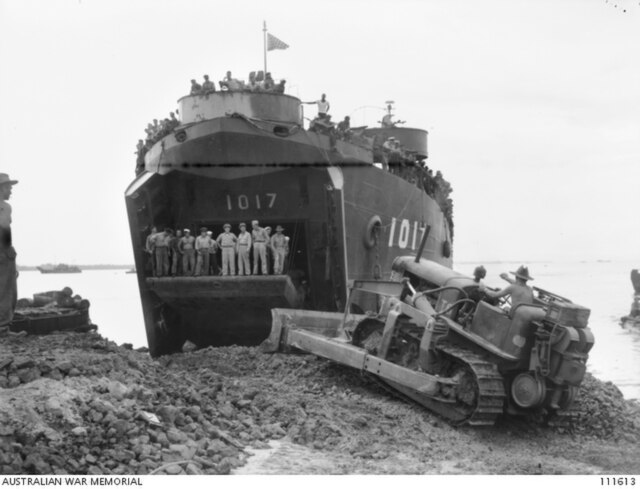 PHILIPPINE CAMPAIGN (1945) On Luzon, in the Cagayan Valley, Ilagan is captured by advancing troops of the US 1st Corps. A-20s and fighter- bombers continue to pound Luzon Island, chiefly around Cagayan Valley, SE of Aparri, and around Cervantes while heavy strikes in the C Cagayan area are in support of guerilla offensive. VOLCANO AND RYUKYU ISLANDS CAMPAIGN On Okinawa, the insistent use of propaganda by means of leaflets and loudspeakers, by the American forces, induces some 343 Japanese troops to surrender. Japanese forces fall back in some disorder along the frontage of the US 3rd Amphibious Corps but continue to resist along the line held by the US 24th Corps. Photo: Three riflemen of the 32nd Regiment, 7th Infantry Division, remain at a safe distance while a flame-throwing tank in the background sprays a Jap emplacement. 19 June, 1945 ALASKA (Eleventh Air Force): In a coordinated shipping search, a B-24 flies the theater's longest mission, a 2,700-mile roundtrip lasting 15.5 hours and flying as far as Uruppu Island, Japan; turning N the B-24 bombs a small convoy 25 miles SW of Shimushu Bay, Shimushu, sinks a vessel, heavily damages another, and sets 2 more afire; another B-24 bombs and photographs Matsuwa Island; 4 B-25s break off a shipping sweep due to the presence of Japanese fighters. PACIFIC Destroyer Dunlap (DD-384), while patrolling north of Chichi Jima, sinks Japanese luggers Gorgen Maru, Legaspi Maru, and cargo ship Kasidori Maru; the enemy vessels are en route to evacuate non-combatants from Chichi Jima to the Japanese home islands, and to take off supplies of gasoline. Twenty-eight USAAF B-29s mine Shimonoseki Straits and the waters off Niigata, Miyazu, and Maizuru, Japan. PB4Y-2s (VPB 118) continue aerial mining of waters in Korean archipelago, sowing mines in the waters north of Roka-To, in a repeat of the mission flown the previous day. On this occasion, however, all planes are damaged by antiaircraft fire when they strafe a ship encountered in the vicinity. Submarine Bullhead (SS-332) sinks Japanese auxiliary sailing vessel No.57 Tachibana Maru in Sunda Strait, off Merak, 05°56'S, 106°00'E. Submarine Cabezon (SS-334), attacking Japanese convoy beset by Apogon (SS-308) the previous day, sinks merchant cargo ship Zaosan Maru southwest of Paramushiro, Kurils, 50°39'N, 154°38'E. Submarine Sea Dog (SS-401), attacking Japanese convoy off northwest coast of Hokkaido, sinks army cargo ship Kokai Maru and merchant cargo ship No.3 Shinhei Maru, and damages merchant vessel Naga Maru, 43°12'N, 140°19'E. Japanese auxiliary submarine chaser Koshun Maru is lost to marine casualty, 4.5 kilometers off Yura Saki, eastern Bungo Suido.. Japanese merchant cargo ship Hattenzan Maru is sunk by aircraft off Masan, Korea; freighter Heian Maru is damaged by marine casualty off Hunghae, 36°03'N, 129°35'E.. Japanese merchant tanker No.1 Nanki Maru is sunk by mine off Aki-Nada, in western part of the Inland Sea; guardboat No.3 Kaigyo Maru is damaged by mine 1.9 kilometers off He Saki, Japan.
|
|
lordroel
Administrator
Posts: 68,086 
Likes: 49,471
|
Post by lordroel on Jun 20, 2024 2:51:41 GMT
Day 2110 of World War II, June 20th 1945United StatesThe United Nations conference settled its last controversy when the Big Five agreed to let the General Assembly have the right to discuss "any matters within the scope of the charter." Photo: The famous British liner, QUEEN MARY, arrives in New York Harbor, June 20, 1945, with thousands of U.S. troops from European battles Photo: Seattle-Tacoma Shipbuilding Corporation, 20 June 1945 Photo: Seattle-Tacoma Shipbuilding Corporation, 20 June 1945 United Kingdom United Kingdom The Polish government in exile denies the right of the Soviets to try the Polish ministers who had flown to Moscow and were arrested. Pacific War CHINA (Fourteenth Air Force): In French Indochina, 8 B-25s and 6 P-51s knock out 2 bridges near Quang Tri and My Chanh and blast surrounding AA positions while 8 fighter-bombers sink at least 3 river steamers in a canal at Haiphong. In China, 37 P-51s hit rail, road, and river traffic, bridges, and general targets of opportunity around Liuchow, Kweilin, Juchai, Hankow, Siangtan, Changsha, Hengshan, Sintsiang, Kweiyi, Kueiyangshih, and Ft Bayard; a bridge at Hankow is destroyed and several others damaged. The 11th Combat Cargo Squadron, Fourteenth AF, move from Yunnani to Luliang, China with C-47s. The Allies agree on a plan to capture Fort Bayard (now Zhanijang), on the South China Sea, by August 1st. The area is intended to serve as a base for operations against Japanese held Hong Kong and Canton. IWO JIMA (Twentieth Air Force): 14 P-47s from Ie Shima bomb and strafe vessels, buildings, a lighthouse, and a village on Amami Gunto Island and the airfield on Tokuno Island; 38 others bomb the airfield at Omura and hit Tokuno on the return trip. SOUTHWEST PACIFIC AREA [Far East Air Force]: B-24s bomb Shinchiku Airfield. The 419th Night Fighter Squadron, XIII Fighter Command, based at Puerto Princesa, Palawan Island with P-61s, sends a detachment to operate from Sanga Sanga (another detachment is at Zamboanga). JAPANESE OCCUPIED WAKE ISLAND US TG 12.4, Lexington, Hancock and Cowpens send air strikes against Japanese positions on Wake Island. This practice will assist them when they join the 3rd Fleet. The USN's Task Group 12.4 launches five strikes against Japanese positions on Wake Island while enroute from Pearl Harbor to Leyte in the Philippine Islands; this is the fifth Wake Raid. TG 12.4 consists of the light aircraft carrier USS Cowpens with Light Carrier Air Group Fifty, and the aircraft carriers USS Hancock with Carrier Air Group Six and USS Lexington with CVG-94 plus escorting vessels. BORNEO CAMPAIGN (1945) On Borneo, Australian forces land at Lutong in eastern Sarawak. B-24s again pound AA positions in the Balikpapan, Borneo area. Tank landing ship LST-562 is damaged when accidentally rammed by tank landing craft LCT-1310, Brunei Bay, Borneo, 04°29'N, 114°01'E. Motor minesweeper YMS-368 is damaged by mine off Balikpapan, Borneo, 01°19'S, 116°58'E. PHILIPPINE CAMPAIGN (1945) On Luzon, Filipino guerrillas advance up the Cagayan valley from Aparri and liberate the town of Tuguegarao. The American regimental task force enters Aparri while elements of the US 37th Division advances 2.5 miles north of Ilagan. Meanwhile, the US 8th Army headquarters announces that operations to recapture the islands of Panay, Negros, Cebu, Bohol and Palawan, as well as the western part of Mindanao, are completed. A-20s and fighter- bombers blast resistance on Luzon Island and directly support a guerilla offensive in the C Cayagan Valley. VOLCANO AND RYUKYU ISLANDS CAMPAIGN On Okinawa, Japanese resistance along the center of the line, held by the US 24th Corps, continues to be strong. The US 32nd Infantry Regiment (US 7th Division) reaches Height 89, near Mabuni, where the Japanese headquarters have been identified. On the flanks, the American Marines on the right and the infantry on the left advance virtually unopposed, capturing over 1000 Japanese and reaching the southern coast of the island at several points. The scale of surrenders is unprecedented for the forces of the Imperial Army. Minesweepers Device (AM-220) and Dour (AM-223) are damaged in collision off Okinawa, 26°00'N, 127°00'E. Tank landing ship LST-288 is damaged by operational casualty off Okinawa. PACIFIC Submarine Kraken (SS-370) sinks Japanese auxiliary sailing vessel No.58 Tachibana Maru in Sunda Strait, off Merak, 05°56'S, 106°00'E. Submarine Tinosa (SS-283), on patrol off the east coast of Korea, sinks Japanese army cargo ship Taito Maru, 36°04'N, 130°26'E, and merchant cargo ship Kaisei Maru, 35°39'N, 130°29'E. Japanese merchant tanker Nanshin Maru is sunk by mine, possibly laid by submarine Ray (SS-271) on 22 February 1944, off Cape St. Jacques, French Indochina. Mine sinks Japanese merchant cargo ship Kenan Maru in north Kyushu channel, 33°59'N, 130°48'E, mine laid by USAAF B-29 (20th Air Force) sinks merchant tanker No.1 Nanki Maru off Aki-Nada, 33°58'N, 131°01'E, and damage merchant cargo ships Nitto Maru 5.7 kilometers off Tateishi light, and Keizan Maru seven kilometers southeast of Motoyamazaki. Cargo ship Huashan Maru is sunk by B-29-laid mine near Fukuoka, Kyushu, 33°38'N, 130°22'E. Japanese merchant cargo ship Kamome Maru is sunk by aircraft between Pusan, Korea, and Yosu. USAAF B-24s (Fifth Air Force) on shipping sweep off coast of Korea sink cargo ship Keijo Maru off Mokpo, 34°47'N, 126°23'E. PB4Y-2s (VPB 118) continue aerial mining of waters of Korean archipelago in a repeat of the mission of the previous day, but on this occasion encounter heavy antiaircraft fire from Japanese warships in the vicinity.
|
|
lordroel
Administrator
Posts: 68,086 
Likes: 49,471
|
Post by lordroel on Jun 21, 2024 7:57:49 GMT
Day 2111 of World War II, June 21st 1945Allied occupied GermanyOtto Skorzeny was interrogated by three Allied Generals regarding his role in the Ardennes Offensive in Wiesbaden, Germany. Soviet UnionTwelve of 16 Poles on trial in Moscow are found guilty of engaging in "underground activities." Photo: Presiding judge of the trial, Colonel-General Vasiliy Ulrikh (centre), listening to defence of imprisoned Polish leaders in Moscow, 21 June 1945. Asscociate judges, Major-General A. Dmitriev (left) and Colonel N. Detistov (right), are on his sides Photo: General Leopold Okulicki, the last commander of the Polish Home Army, in conversation with Stanisław Jasiukowicz, one of the Polish Secret State leaders, during the staged trial in Moscow, 21 June 1945 Photo: General Leopold Okulicki, the last commander of the Polish Home Army, in conversation with Stanisław Jasiukowicz, one of the Polish Secret State leaders, during the staged trial in Moscow, 21 June 1945 Photo: Stanislaw Jasiukowicz. Stanisław Jasiukowicz, a member of the Polish Government-in-Exile's Delegation for Poland, defending himself during the staged trial in Moscow, 21 June 1945 Photo: Stanislaw Jasiukowicz. Stanisław Jasiukowicz, a member of the Polish Government-in-Exile's Delegation for Poland, defending himself during the staged trial in Moscow, 21 June 1945 Italy ItalyFerruccio Parri replaced Ivanoe Bonomi as Prime Minister of Italy. Pacific War CHINA (Fourteenth Air Force): In French Indochina, 16 B-25s bomb an enemy fort at Bac Ninh, hit railroad yards and trains at Thanh Hoa, Phu Dien, Yen Li Station, Ha Trung, and Ninh Binh, damage a tunnel at La Son, bomb a barge concentration at Ha Dong, and attack a train near the Duc Tho bridge. 40+ P-51s and P-38s hit road, rail, and river transport, coastal shipping, troops, supply lines, and targets of opportunity in French Indochina and S and E China. GUAM (Seventh Air Force): 24 B-24s from Guam bomb fuel oil storage and power plant buildings on Eten. The detachment of the 28th Photographic Reconnaissance Squadron, Seventh AF, operating from Ie Shima with F-5Es, returns to base on Okinawa. TINIAN (Twentieth Air Force): Mission 214: 25 B-29s mine the sea approaches around Fushiki, Senzaki, Nanao, and Yuya Bay, Japan during the night of 21/22 Jun; 2 others mine alternate areas. SOUTHWEST PACIFIC AREA [Far East Air Force]: On Formosa, P-38s hit targets at Mato and Kagi and targets of opportunity along the western coast. JAPANESE OCCUPIED KOREA USN PB4Y-2 Privateers of Patrol Bombing Squadron One Hundred Eighteen sow mines between Hakin Do, Iion Do and Gantai Do in the Korean Archipelago. BORNEO CAMPAIGN (1945) On Borneo, in the north there is a new landing by the Australian 9th Division. Labaum Island is report to be secured. Map: A map showing the fighting on the island of Labuan between 10 and 21 June 1945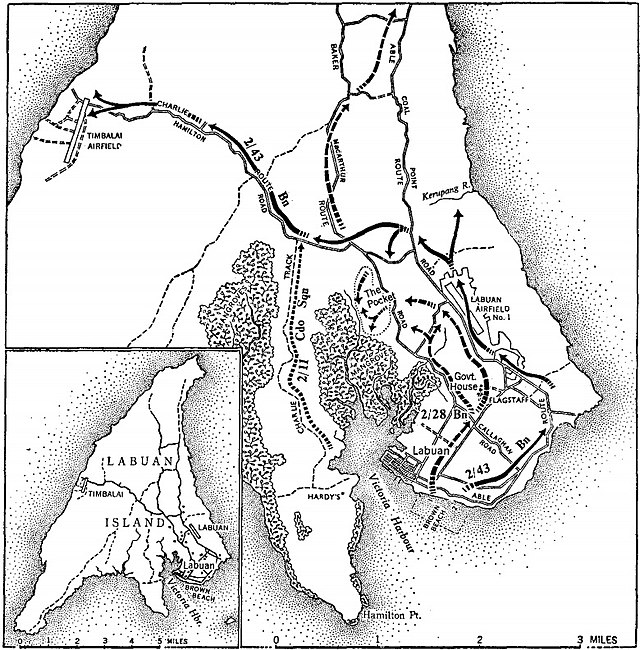 Map: A map showing the Tarakan operations between 1 May and 21 June 1945 Map: A map showing the Tarakan operations between 1 May and 21 June 1945
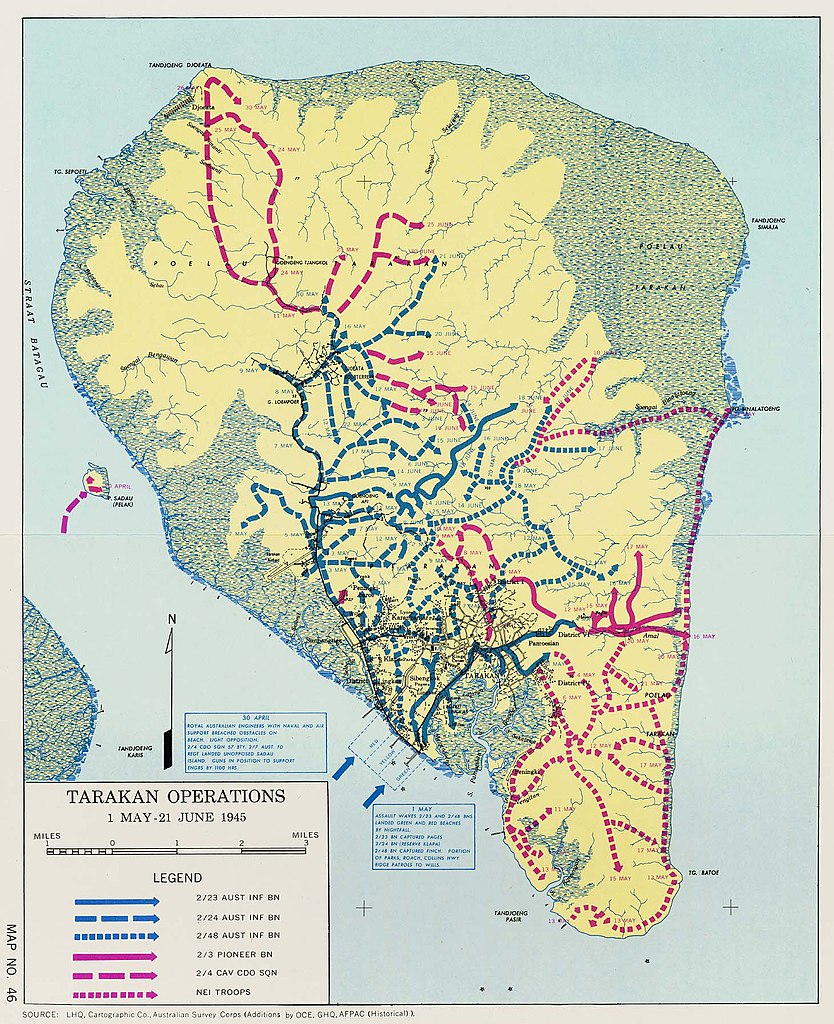 In Borneo, B-24s pound the Balikpapan town area, Manggar Airfield, Sepinggang defenses, and Oelin Airfield and B-25s bomb the town of Keningau while P-38s blast the nearby airfield; the fighter-bombers attack Kudat and caves near Jesselton. PHILIPPINE CAMPAIGN (1945) On Luzon, the last Japanese-held port, Aparri, falls to American forces. The American regimental task force make contact with Filipino guerrillas. Fighter-bombers attack positions and supply areas in the the Cagayan Valley, other locations in N Luzon and in the Marikina and Infanta areas in C Luzon. VOLCANO AND RYUKYU ISLANDS CAMPAIGN On Okinawa, the Japanese headquarters on Hill 89 is taken by the forces of the US 32nd Infantry Regiment, part of US 7th Division. The body of General Ushijima, commanding the Japanese 32nd Army is found nearby. Okinawa is declared secured 82 days after the initial landings; Japanese air attacks on U.S. ships offshore, however, continue. Kamikazes damage destroyer escort Halloran (DE-305), 26°00'N, 128°00'E, and sink medium landing ship LSM-59, while she is escorting fleet tug Lipan (ATF-85) and high speed transport Barry (APD-29). Barry (previously damaged by kamikaze on 24 May) and in tow of Lipan, is en route to Ie Shima (see 22 May 1945 and 22 June).17 In addition, suicider planes damage seaplane tenders Curtiss (AV-4) and Kenneth Whiting (AV-14), 26°10'N, 127°18'E. Photo: The caption on this photograph reads "Celebration on Hill 89-First Division Marines and Seventh Division Soldiers cheer the victory atop hill #89 after the official flag raising ceremonies. The sign reads "Within this hill is sealed the command post where Lieutenant General Ushijima commander of the Japanese Army surrounded by his senior officers made his final stand. This hill was seized by troops of the Seventh Infantry Division on June 21, 1945, thus ending the battle of Okinawa" PACIFIC Twenty-seven USAAF B-29s mine the waters off Oura, Senzaki, Nanao, Fushiki and Osaka, Japan. PB4Y-2s (VPB 118), flying from Okinawa, continue aerial mining of waters of Korean archipelago, sowing mines in waters in channel between Hikin-To, Iion-To, and Gantai-To; one plane encounters antiaircraft fire from Japanese warship in vicinity. Waters north of Roka-To are mined again as well. Landing craft repair ship Endymion (ARL-9) is damaged by Japanese submarine I 36 north of Truk, 12°41'N, 156°20'E. Motor minesweeper YMS-335 is damaged by shore battery, Balikpapan, Borneo, 01°18'S, 116°50'E. Submarine Parche (SS-384) sinks Japanese merchant cargo ship Hizen Maru, 41°19'N, 141°28'E. Submarine Piranha (SS-389) damages Japanese merchant cargo ship Shirogane Maru, 39°28'N, 142°10'E.
|
|
lordroel
Administrator
Posts: 68,086 
Likes: 49,471
|
Post by lordroel on Jun 22, 2024 16:18:54 GMT
Day 2112 of World War II, June 22nd 1945YouTube (Okinawa Taken)Allied occupied GermanyOtto Skorzeny was transferred from a makeshift prison cell to the city jail of Wiesbaden, Germany. Soviet UnionViktor Abakumov wrote to Lavrentiy Beria complaining of Ivan Serov's interference with Soviet SMERSH business. Beria, with Joseph Stalin's approval, instead made Serov the plenipotentiary of all Soviet counterintelligence in Germany, thus expanding NKVD's control over SMERSH in the occupied country. Abakumov refused to allow his subordinates to follow Serov's command, however, thus Serov's authority would only be nominal. ww2dbase United StatesPhoto: The U.S. Navy aircraft carrier USS Lake Champlain (CV-39) underway at sea on 22 June 1945. She had been commissioned on 3 June 1945. Several Grumman TBM Avenger and a Curtiss SB2C Helldiver are near the island, a Vought F4U Corsair is parked on the lowered port elevator Pacific War Pacific War CHINA (Fourteenth Air Force): 23 B-25s and 4 P-47s pound trucks, trains, and gun positions in the Hanoi, French Indochina area, and in China, bomb railroad yards and barracks area at Sinsiang, hit rail and road targets, buildings, and radar station in the Showyang area, knock out a bridge S of Saiping, and damage a bridge N of Hsuchang; 40+ fighters hit rail, road, and river traffic, artillery emplacements, line positions, and other targets in French Indochina and S and E China. Japanese troops evacuate Liuchow, setting it on fire before the approaching Chinese forces. INDIA-BURMA (Tenth Air Force): The 5th and 6th Fighter Squadrons (Commando), 1st Air Commando Group, moves from Kalaikunda to Asansol, India with P-47s. JAPANESE OCCUPIED KOREA PB4Y-2s (VPB 118), flying from Okinawa, continue aerial mining of waters of Korean archipelago, sowing mines in waters in channel north of Iion-To and Gantai-To, and off Ninshi-To and Chi-To. JAPAN Request by Emperor Hirohito for peace talks. "I desire that concrete plans to end the war, unhampered by existing policy, be speedily studied and that efforts made to implement them." American B-29 Superfortress bombers drop about 3000 tons of bombs on Japanese munitions plants in Kobe, Osaka, Nagoya and Okayama. Twenty-six USAAF B-29s mine the waters off Karatsu, Fukuoka, Sakai, and Niigata, Japan. OKINAWA The battle ends. American forces have lost 12,500 dead and 35,500 wounded. The US navy has had 36 ships sunk and 368 damaged. In the air, the American forces have lost 763 planes. The Japanese losses include 120,000 military and 42,000 civilian dead. For the first time in the war, there are a relatively large number of Japanese prisoners: 10,755. American reports claim the Japanese have lost 7,830 planes. General Douglas MacArthur announced that Joseph Stilwell had been made the new commander of the U.S. Tenth Army, replacing Simon Bolivar Buckner, Jr. who had been killed in action four days earlier. TINIAN (Twentieth Air Force): 446 B-29s are dispatched in 6 missions to targets on S Honshu Island, Japan during the day. Mission 215: 162 B-29s attack the Kure Naval Arsenal and 12 others hit alternate targets; 72% of the roof area of the arsenal is damaged; 2 B-29s are lost. Mission 216: 108 B-29s hit the Mitsubishi aircraft plant at Tamashima destroying 135 of 231 machine tools and almost half the roof area; 10 others hit alternate targets; 2 B-29s are lost. Mission 217: 52 B-29s attack the Kawanishi aircraft plant at Himeji causing great destruction among the buildings and total destruction of machine tools; 4 others hit alternate targets. Missions 218 and 219: 34 B-29s hit the Mitsubishi and Kawasaki aircraft plants at Kagamigahara and 10 others hit alternate targets; 1 B-29 is lost. Mission 220: 25 B-29s hit the Kawasaki aircraft factory at Akashi and 1 hits an alternate target. 40+ P-47s from Ie Shima fly combat patrols over Amami Gunto Island, Japan, claiming 11 Japanese aircraft downed. SOUTHWEST PACIFIC AREA [Far East Air Force]: On Formosa, B-24s hit Toshien oil facilities and P-38s attack Mato while 2 B-32s blast gun positions and barracks at Heito. The 25th Liaison Squadron, 13th AF, moves from Malabang to Del Monte, Mindanao Island with UC-78s and L-5s. BORNEO CAMPAIGN (1945) On Tarakan, off the northeast coast of Borneo, Australian forces have eliminated all Japanese resistance. On Borneo, the city of Sarawak is captured. Photo: A oil well burning furiously, one of 35 set on fire by the retreating Japanese, Seria Area, 22 June 1945 Photo: Battalion headquarters, 2/17 Infantry Battalion at Seria. Army vehicles in foreground; smoke from burning oil well in background, 22 June 1945 Photo: Battalion headquarters, 2/17 Infantry Battalion at Seria. Army vehicles in foreground; smoke from burning oil well in background, 22 June 1945 Photo: Jeep waiting to go on the Tutong ferry which is operated by members of the 2/3 Field Company, Royal Australian Engineers, 22 June 1945 Photo: Jeep waiting to go on the Tutong ferry which is operated by members of the 2/3 Field Company, Royal Australian Engineers, 22 June 1945  In Borneo, B-24s pound Balikpapan area gun and defensive positions while B-25s hit nearby warehouses and numerous other buildings and P-38s dive-bomb and score direct hits on pillboxes. Motor minesweeper YMS-364 is damaged by shore battery, Balikpapan, Borneo, 01°19'S, 116°52'E. PHILIPPINE CAMPAIGN (1945) Fighter-bombers supporting ground action continue to hit concentrations and positions in the Cagayan Valley on Luzon Island. ALASKA (Eleventh Air Force): Major General John B Brooks relieves Brigadier General Isaiah Davies as Commanding General, Eleventh AF. PACIFIC Submarine Hardhead (SS-365) sinks Japanese auxiliary submarine chaser Cha 42 in Java Sea, 05°44'S, 114°16'E, and after undergoing counterattack by auxiliary submarine chaser Cha 113, sinks Cha 113 and No. 833 Shuttle Boat, 05°45'S, 114°16'E. Submarine Tirante (SS-420) sinks Japanese merchant sailing junk No.293 Antung Maru, 37°54'N, 125°34'E. Mines sink Japanese merchant cargo ship Goshu Maru off Mutsure light, and damage merchant cargo ship Kocho Maru 1.5 kilometers off Takenoko light. Japanese merchant cargo ship Shingishu Maru is damaged by aircraft off Pusan, Korea.
|
|
lordroel
Administrator
Posts: 68,086 
Likes: 49,471
|
Post by lordroel on Jun 23, 2024 6:04:37 GMT
Day 2113 of World War II, June 23rd 1945United StatesRepresentatives of the Big Four powers (China, the United Kingdom, the United States and the Soviet Union) agreed to admit Poland to the United Nations. Soviet Union The rival parties claiming the right to rule Poland reach an agreement on power sharing. American and British objections to the Lublin Committee Poles, supported by the Soviet Union, are met with the inclusion of three of the Poles from the London based government in exile. Among the three is Stanislaw Mikolajczyk, the former premier, who is to be the deputy premier. In addition, two non-Communist Poles from within Poland are included in the new provisional government. The Communists and their opponents are therefore to share power more equitably than originally thought possible. Pacific WarCHINA (Fourteenth Air Force): In French Indochina, 4 B-25s knock out the E approach to the Phu Lang Thuong bridge and 4 P-38s bomb locomotives and a barracks area at Les Pins and Lang Son. 12 P-51s strafe airfields in the Canton, China area. 17 other fighters strafe railroad targets and river traffic around Wuchou, Siaokan, and Peking, China, and Hanoi, and Vinh, French Indochina. TINIAN (Twentieth Air Force): Mission 221: In Japan, during the night of 23/24 Jun, 26 B-29s mine the harbors of Fukuoka, Karatsu, Sakai, and Niigata; 1 B-29 is lost; 38 P-47s from Ie Shima bomb airfields at Hakata and Itazuke and, during the return flight, attack 2 boats off Amami Gunto Island; 40 other P-47s bomb Saitozaki Airfield; 100 P-51s are dispatched from Iwo Jima to airfields at Kagamigahara and Hyakuri; they claim 19-3-16 aircraft in the air and 13-40 on the ground; 3 P-51s are lost. SOUTHWEST PACIFIC AREA [Far East Air Force]: B-24s bomb a butanol plant at Kobi, Formosa. BORNEO CAMPAIGN (1945) The last organized Japanese defense was broken by Australian troops at Tarakan Island, Borneo. 150+ B-24s, B-25s, and fighter-bombers continue heavy strikes against the Balikpapan, Borneo area concentrating on gun emplacements and defensive positions. PHILIPPINE CAMPAIGN (1945) American paratroopers land near Aparri on the north coast of Luzon, at the mouth of the Cagayan River, without incident. They link up with a large force of Filipino guerrillas. The combined force advances southward to make contact with the US 37th Division. Photo: 4 gun, 105 howitzer, of the 64th F.A. Bn., 25th Inf. Div., showing how it is dug in on the road to Balete Pass, Luzon, P.I, 23 June 1945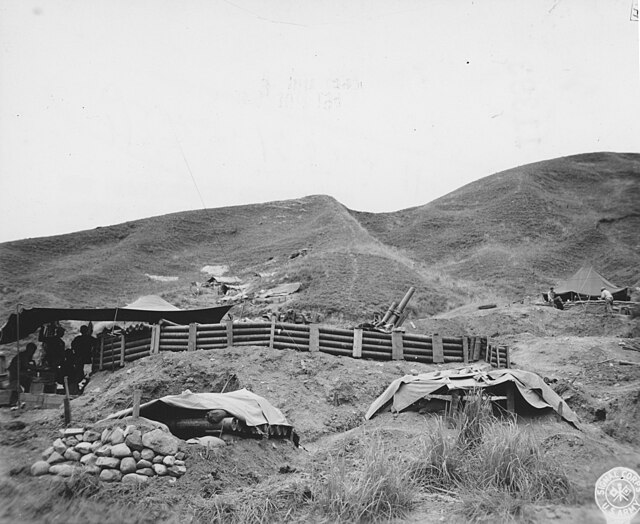 A-20s and fighter-bombers pound troop concentrations and occupied areas in the Cagayan Valley and fighter-bombers attack pockets of resistance in the Infanta and Antipolo areas. OKINAWA On Okinawa, the systematic mopping up of the island begins. General Stilwell takes command of the US 10th Army in place of General Geiger. US General Stillwell is appointed to command the US 10th Army on Okinawa. He replaces US General Simon Buckner who was KIA by an artillery round on the 18th. ALASKA (Eleventh Air Force): In the Kurile Islands, 2 B-24s on a shipping sweep between Matsuwa and Paramushiru Islands sink 1 freighter, damage 2 more, and hit a whale boat; 1 Japanese fighter is claimed destroyed; 6 more B-24s bomb Kataoka on Shimushu. PACIFIC Twenty-six USAAF B-29s mine the waters off Karatsu, Fukuoka, Sakai, and Niigata, Japan. PB4Y-2s (VPB 118), flying from Okinawa, continue aerial mining of waters of Korean archipelago, sowing mines in waters in channel north of Iion-To and Gantai-To, and off Ninshi-To and Chi-To. Motor minesweeper YMS-364 is damaged by shore battery, Balikpapan, Borneo, 01°19'S, 116°52'E. Submarine Hardhead (SS-365) sinks Japanese auxiliary submarine chaser Cha 42 in Java Sea, 05°44'S, 114°16'E, and after undergoing counterattack by auxiliary submarine chaser Cha 113, sinks Cha 113 and No. 833 Shuttle Boat, 05°45'S, 114°16'E. Submarine Tirante (SS-420) sinks Japanese merchant sailing junk No.293 Antung Maru, 37°54'N, 125°34'E. Mines sink Japanese merchant cargo ship Goshu Maru off Mutsure light, and damage merchant cargo ship Kocho Maru 1.5 kilometers off Takenoko light. Japanese merchant cargo ship Shingishu Maru is damaged by aircraft off Pusan, Korea.
|
|




















































































